Paul van Yperen's Blog, page 346
May 12, 2016
EFSP's Dazzling Dozen: The Eurovision Song Contest
EFSP salutes the European Song Contest! Even down under, in Australia, they know it's a fabulous event. Tomorrow night the finals of the 60th Eurovision Song Contest take place in Stockholm, Sweden. EFSP presents you the postcards of twelve dazzling participants of the past.
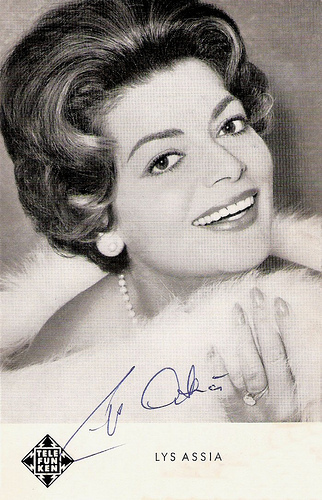
The winner of the very first Eurovision Song Contest in 1956 was Swiss singer and actress Lys Assia (1924).
German card by Telefunken Schallplatten. Photo: Teldec/Haenchen.
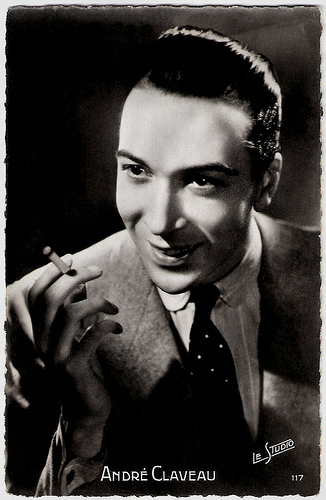
From the 1940s to the 1960s, André Claveau (1911–2003) was a popular singer and film actor in France. He won the 1958 Eurovision Song Contest with Dors, mon amour (Sleep, My Love).
French postcard by O.P, Paris, no. 117. Photo: Le Studio.
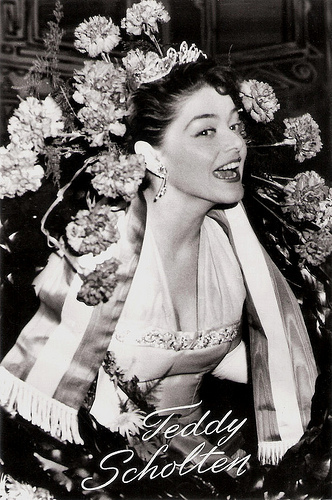
The winner of the Eurovision Song Contest 1959 was Dutch singer Teddy Scholten (1926-2010).
Dutch postcard by Uitg. Takken, Utrecht, no. 4000. Photo: 't Sticht, Utrecht.
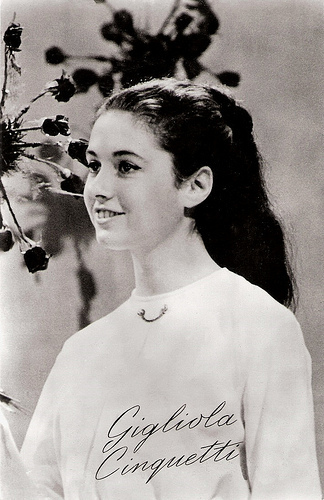
At the age of 16, Italian singer Gigliola Cinquetti (1947) won Festival di Sanremo with Non ho l'età and with the same song she won the Eurovision Song Contest 1964 and scored her first international hit.
Dutch postcard by Takken, Utrecht, no. AX 5908.
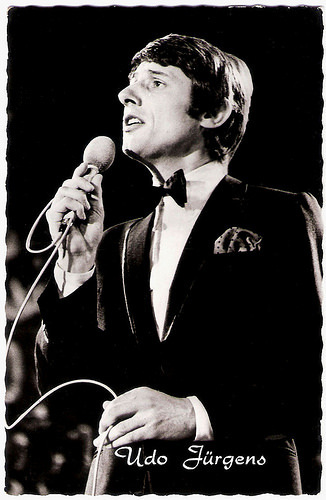
Udo Jürgens (1934-2014) was one of the biggest stars and entertainers in the German speaking countries. In 1966, he was the first Austrian winner of the Eurovision Song Contest with Merci, Chérie.
German postcard by Filmbilder-Vertrieb Ernst Freihoff, Essen, no. AX 7081. Photo: Ariola.
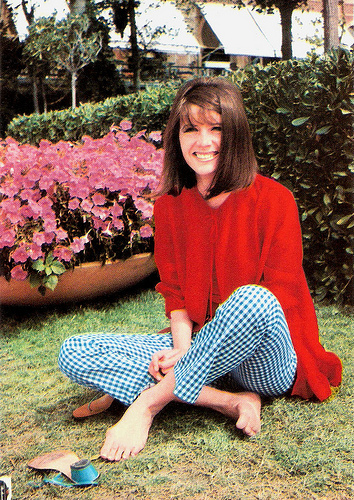
British singer Sandie Shaw (1947) was 'the barefoot pop princess of the 1960s' after she had won the Eurovision Song Contest in 1967. She was the first UK act to win!
Italian postcard. Photo: Voce del Padrone.
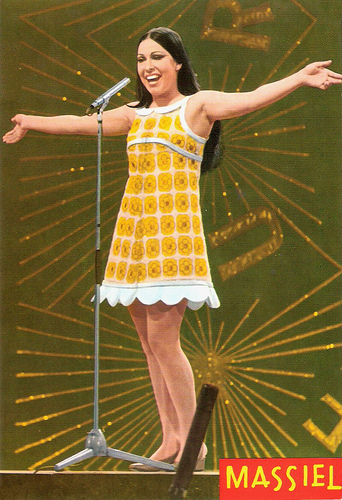
Spanish pop singer Massiel (1947) won the Eurovision Song Contest 1968 with the song La, la, la, beating Cliff Richard's Congratulations. Spanish postcard by Postal Oscar Color S.A., Barcelona, no. 782. Photo: H. Segui.
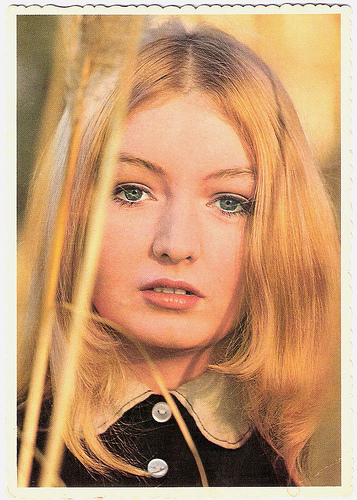
Welsh folk singer Mary Hopkin (1950) is best known for her 1968 UK number one single Those Were The Days, produced by Paul McCartney. She represented the United Kingdom in the 1970 Eurovision Song Contest singing Knock, Knock Who's There?. Hopkin came second to All Kinds of Everything, performed by Irish singer Dana.
British postcard by Valentine's Postcard Communication.
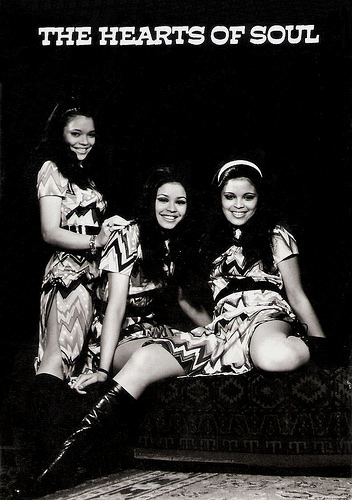
Hearts of Soul was formed by three Dutch Indo sisters: Bianca, Stella and Patricia Maessen (1952-1996). In 1970, they sung Waterman as the entry of the Netherlands at the Eurovision Song Contest. They ended seventh. Dutch promotion card by Basart Records International, Amsterdam. Photo: Wim Heiblom. The Hearts of Soul were dressed by Shubette of London.
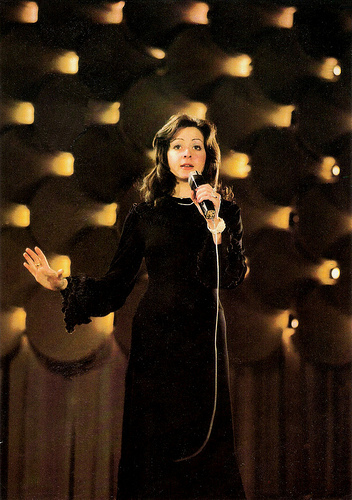
Vicky Leandros (1949) is a Greek singer with a long international career. In 1972, she achieved worldwide fame after winning the Eurovision Song Contest with the song, Après Toi, while representing Luxembourg.
Big East-German card by VEB Lied der Zeit Musikverlag, Berlin, 1980. Photo: Hartmut Schorsch, Berlin.
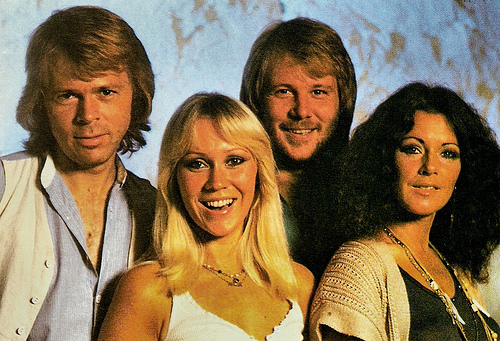
ABBA were the winners at the Eurovision Song Contest in 1974, giving Sweden its first victory in the history of the contest and being the most successful group ever to take part in the tournament. Swedish postcard by Ultraförlaget A.B., Stockholm, no. 28 - 012. Photo: Torbjörn Calvero.
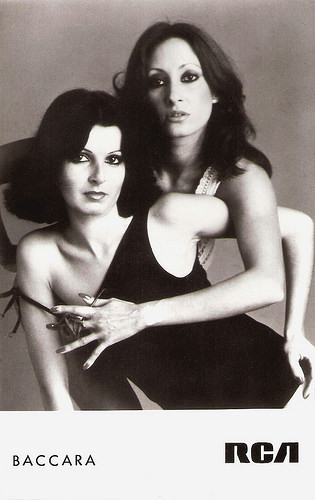
Baccara was a female vocal duo formed in 1977 by Spanish artists Mayte Mateos (1951) and María Mendiola (1952). The pair rapidly achieved international success with their debut single Yes Sir, I Can Boogie, which reached number one across much of Europe. In 1978 the duo represented Luxembourg at the Eurovision Song Contest. They finished seventh with Parlez vous Français?
German promotion card. Photo: RCA.
This is a post for Postcard Friendship Friday, hosted by Beth at the The Best Hearts are Crunchy. You can visit her by clicking on the button below.


The winner of the very first Eurovision Song Contest in 1956 was Swiss singer and actress Lys Assia (1924).
German card by Telefunken Schallplatten. Photo: Teldec/Haenchen.

From the 1940s to the 1960s, André Claveau (1911–2003) was a popular singer and film actor in France. He won the 1958 Eurovision Song Contest with Dors, mon amour (Sleep, My Love).
French postcard by O.P, Paris, no. 117. Photo: Le Studio.

The winner of the Eurovision Song Contest 1959 was Dutch singer Teddy Scholten (1926-2010).
Dutch postcard by Uitg. Takken, Utrecht, no. 4000. Photo: 't Sticht, Utrecht.

At the age of 16, Italian singer Gigliola Cinquetti (1947) won Festival di Sanremo with Non ho l'età and with the same song she won the Eurovision Song Contest 1964 and scored her first international hit.
Dutch postcard by Takken, Utrecht, no. AX 5908.

Udo Jürgens (1934-2014) was one of the biggest stars and entertainers in the German speaking countries. In 1966, he was the first Austrian winner of the Eurovision Song Contest with Merci, Chérie.
German postcard by Filmbilder-Vertrieb Ernst Freihoff, Essen, no. AX 7081. Photo: Ariola.

British singer Sandie Shaw (1947) was 'the barefoot pop princess of the 1960s' after she had won the Eurovision Song Contest in 1967. She was the first UK act to win!
Italian postcard. Photo: Voce del Padrone.

Spanish pop singer Massiel (1947) won the Eurovision Song Contest 1968 with the song La, la, la, beating Cliff Richard's Congratulations. Spanish postcard by Postal Oscar Color S.A., Barcelona, no. 782. Photo: H. Segui.

Welsh folk singer Mary Hopkin (1950) is best known for her 1968 UK number one single Those Were The Days, produced by Paul McCartney. She represented the United Kingdom in the 1970 Eurovision Song Contest singing Knock, Knock Who's There?. Hopkin came second to All Kinds of Everything, performed by Irish singer Dana.
British postcard by Valentine's Postcard Communication.

Hearts of Soul was formed by three Dutch Indo sisters: Bianca, Stella and Patricia Maessen (1952-1996). In 1970, they sung Waterman as the entry of the Netherlands at the Eurovision Song Contest. They ended seventh. Dutch promotion card by Basart Records International, Amsterdam. Photo: Wim Heiblom. The Hearts of Soul were dressed by Shubette of London.

Vicky Leandros (1949) is a Greek singer with a long international career. In 1972, she achieved worldwide fame after winning the Eurovision Song Contest with the song, Après Toi, while representing Luxembourg.
Big East-German card by VEB Lied der Zeit Musikverlag, Berlin, 1980. Photo: Hartmut Schorsch, Berlin.

ABBA were the winners at the Eurovision Song Contest in 1974, giving Sweden its first victory in the history of the contest and being the most successful group ever to take part in the tournament. Swedish postcard by Ultraförlaget A.B., Stockholm, no. 28 - 012. Photo: Torbjörn Calvero.

Baccara was a female vocal duo formed in 1977 by Spanish artists Mayte Mateos (1951) and María Mendiola (1952). The pair rapidly achieved international success with their debut single Yes Sir, I Can Boogie, which reached number one across much of Europe. In 1978 the duo represented Luxembourg at the Eurovision Song Contest. They finished seventh with Parlez vous Français?
German promotion card. Photo: RCA.
This is a post for Postcard Friendship Friday, hosted by Beth at the The Best Hearts are Crunchy. You can visit her by clicking on the button below.

Published on May 12, 2016 22:00
May 11, 2016
Wundersam ist das Märchen der Liebe (1918)
The German silent film Wundersam ist das Märchen der Liebe/Wondrous is the story of love (Leo Connard, 1918) is an Orientalist drama, produced by Hella Moja-Film GmbH. Producer Hella Moja is also the star of the film. She is a beautiful orphan, married to a prince. Because of jealousy, her husband abandons her. When she is about to commit suicide, he accepts her again. Other actors in the film were Ernst Hofmann, Marie Connard and the film's director, Leo Connard. Wundersam ist das Märchen der Liebe premiered in July 1918 at the Berlin movie palace Marmorhaus.
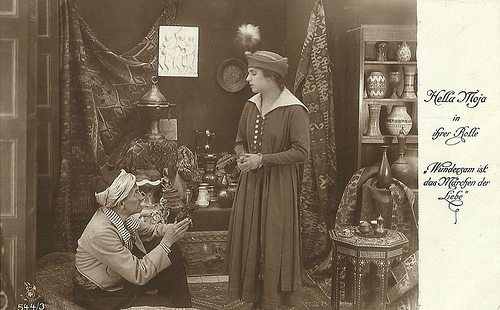
German postcard by Rotophot in the Film-Sterne series, no. 544/3. Photo: Hella Moja-Film GmbH. Hella Moja in Wundersam ist das Märchen der Liebe (Leo Connard, 1918).
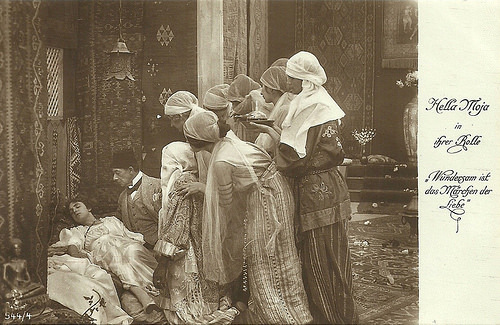
German postcard by Rotophot in the Film-Sterne series, no. 544/4. Photo: Hella Moja-Film GmbH. Hella Moja in Wundersam ist das Märchen der Liebe (Leo Connard, 1918).
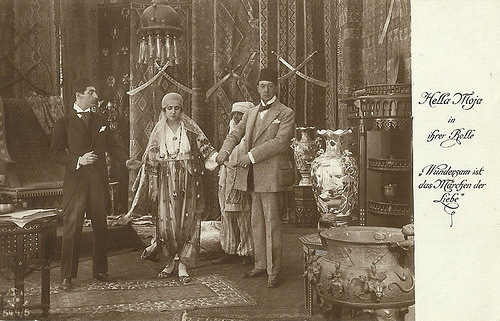
German postcard by Rotophot in the Film-Sterne series, no. 544/5. Photo: Hella Moja-Film GmbH. Hella Moja in Wundersam ist das Märchen der Liebe (Leo Connard, 1918).
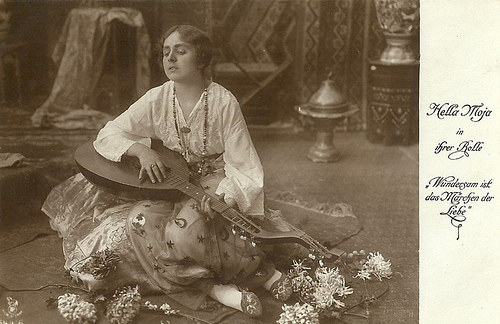
German postcard by Rotophot in the Film-Sterne series, no. 544/6. Photo: Hella Moja-Film GmbH. Hella Moja in Wundersam ist das Märchen der Liebe (Leo Connard, 1918).
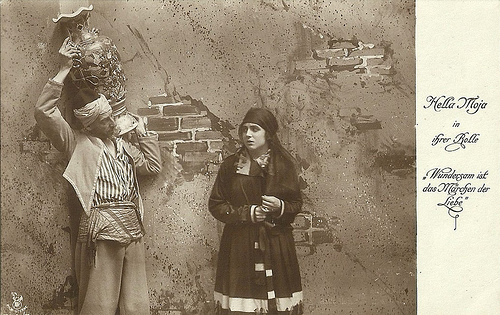
German postcard by Rotophot in the Film-Sterne series, no. 544/7. Photo: Hella Moja-Film GmbH. Hella Moja in Wundersam ist das Märchen der Liebe (Leo Connard, 1918).
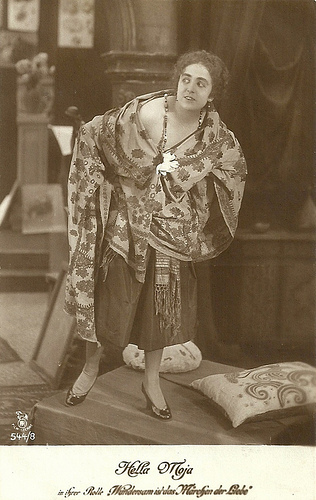
German postcard by Rotophot in the Film-Sterne series, no. 544/8. Photo: Hella Moja-Film GmbH. Hella Moja in Wundersam ist das Märchen der Liebe (Leo Connard, 1918).

German postcard by Rotophot in the Film-Sterne series, no. 544/3. Photo: Hella Moja-Film GmbH. Hella Moja in Wundersam ist das Märchen der Liebe (Leo Connard, 1918).

German postcard by Rotophot in the Film-Sterne series, no. 544/4. Photo: Hella Moja-Film GmbH. Hella Moja in Wundersam ist das Märchen der Liebe (Leo Connard, 1918).

German postcard by Rotophot in the Film-Sterne series, no. 544/5. Photo: Hella Moja-Film GmbH. Hella Moja in Wundersam ist das Märchen der Liebe (Leo Connard, 1918).

German postcard by Rotophot in the Film-Sterne series, no. 544/6. Photo: Hella Moja-Film GmbH. Hella Moja in Wundersam ist das Märchen der Liebe (Leo Connard, 1918).

German postcard by Rotophot in the Film-Sterne series, no. 544/7. Photo: Hella Moja-Film GmbH. Hella Moja in Wundersam ist das Märchen der Liebe (Leo Connard, 1918).

German postcard by Rotophot in the Film-Sterne series, no. 544/8. Photo: Hella Moja-Film GmbH. Hella Moja in Wundersam ist das Märchen der Liebe (Leo Connard, 1918).
Published on May 11, 2016 22:00
May 10, 2016
Isabelle Huppert
Today is the opening night of the 69th Festival de Cannes. In the official selection is the new film by Dutch director Paul Verhoeven, Elle (2016). How I am looking forward to see this thriller! French actress Isabelle Huppert (1953) plays a top exec for a video-game company who turns the tables after being violated in a home invasion. The versatile Huppert appeared in more than 90 film and television productions since 1971.
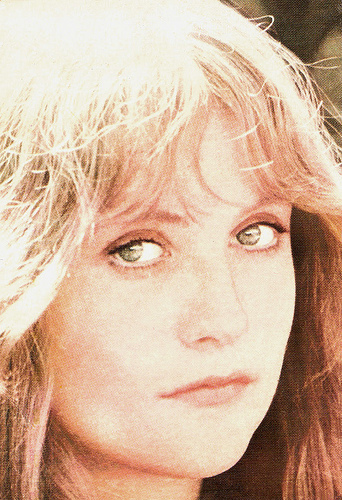
Romanian postcard by Casa Filmului Acin.
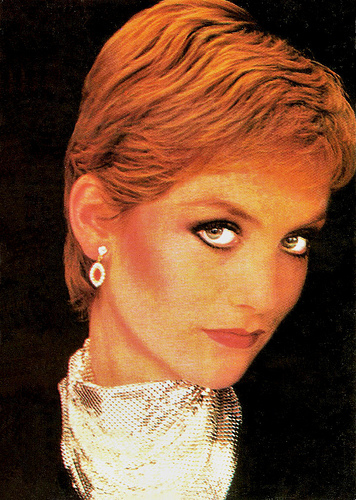
Romanian postcard by Casa Filmului Acin.
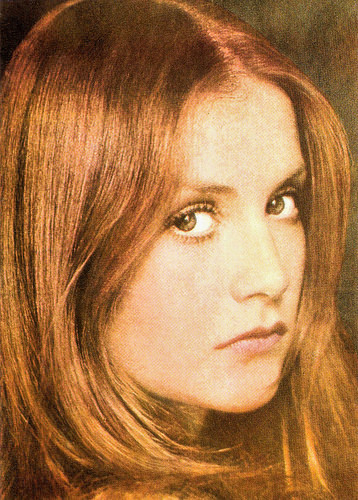
Romanian postcard by Casa Filmului Acin.
Casually Poisoning Her Parents
Isabelle Anne Madeleine Huppert was born in Paris in 1953 (some sources say 1955). She is the youngest of five daughters of Annick Beau, a teacher of English, and Raymond Huppert, a safe manufacturer.
At age 13, she announced her intention to be an actor, and was encouraged by her mother. She studied at the Versailles Conservatoire and later attended the CNSAD (National Conservatory of Dramatic Art of Paris).
Huppert made her film debut in Faustine et le bel été/Faustine and the Beautiful Summer (Nina Companeez, 1972). Five years later, she already had appeared in 15 films and had worked with major directors. She played Romy Schneider 's younger sister in César et Rosalie/Cesar and Rosalie (Claude Sautet, 1972).
In Bertrand Blier’s road movie Les valseuses/Going Places (1974), she played a bored teenager who runs off with three young vagabonds ( Gérard Depardieu , Patrick Dewaere and Miou-Miou). For director Otto Preminger, Huppert made her English-language debut in Rosebud (1975) starring Peter O’Toole .
Her international breakthrough came with her guileless performance as a simple, provincial girl destroyed by a summer romance with a middle-class student in La Dentelliere/The Lacemaker (Claude Goretta, 1977). For this unforgettable portrayal she was awarded with both a BAFTA award (British Academy Award) and a David di Donatello (the Italian Oscar).
At the next Cannes film festival, she won the Best Actress award for Violette Nozière (Claude Chabrol, 1978). In this true story, she portrayed a woman who scandalized France in 1933 by casually poisoning her parents. She tied the award with Jill Clayburgh.
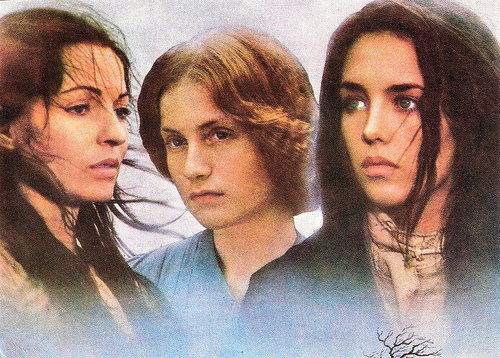
Romanian postcard by Casa Filmului Acin. Photo: publicity still for Les soeurs Brontë/The Bronte Sisters (André Téchniné, 1979) with Marie-France Pisier as Charlotte Bronte, Isabelle Huppert as Anne Bronte, and Isabelle Adjani as Emily Brontë.
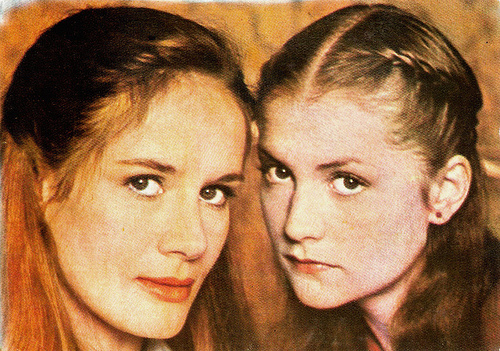
Dominique Sanda and Isabelle Huppert. Romanian postcard by Casa Filmului Acin. Publicity still for Les ailes de la colombe/The Wings of the Dove (Benoît Jacquot, 1981).
Legendary Disaster
Isabelle Huppert made her American film debut in the blockbuster Heaven's Gate (Michael Cimino, 1980), which proved to be a legendary disaster at the box office.
In France she continued to explore enigmatic and emotionally distant characters, such as an upper-class woman who is physically attracted by a young vagabond ( Gérard Depardieu ) in Loulou (Maurice Pialat, 1980), a prostitute in Sauve qui peut (la vie)/Slow Motion (Jean-Luc Godard, 1980), the mistress of Philippe Noiret ’s character in Coup de torchon/Clean Slate (Bertrand Tavernier, 1981) and a Jewish refugee in Coup de foudre/Entre nous (Diane Kurys, 1983).
She used her influence to help non-commercial projects get off the ground, like Joseph Losey's La Truite/The Trout (1982) and sister Caroline Huppert's Signé Charlotte/Sincerely, Charlotte (1984).
For her role in Une Affaire de Femmes/Story of Women (Claude Chabrol, 1988), she received the Volpi Cup for Best Actress at the Venice film festival. This time, she tied with Shirley MacLaine. She won the Volpi Cup again for her role in La Cérémonie (Claude Chabrol, 1995) as a shy but manic and homicidal post-office mistress in a French village. This time she tied the award with her co-star in that film, Sandrine Bonnaire. For La Cérémonie, she also won her only César award.
The offspring of her cinematic relationship with director Claude Chabrol also includes the widely acclaimed literary adaptation Madame Bovary (1991), the crime comedy Rien ne va plus/The Swindle (1997), and the thriller Merci pour le chocolat/Thanks for the Chocolate (2000).
Stuart Jeffries in The Observer about their cooperation: “Huppert has excelled in the spiteful, the nasty, the unpleasant and - regularly - the murderous. More than that, she carries herself with imperious intelligence, and thus seems to be self-conscious about her own wickedness. No doubt that is why Chabrol has cast her so often. He's interested in guilt, manipulativeness and shame - all of which she loves portraying.”
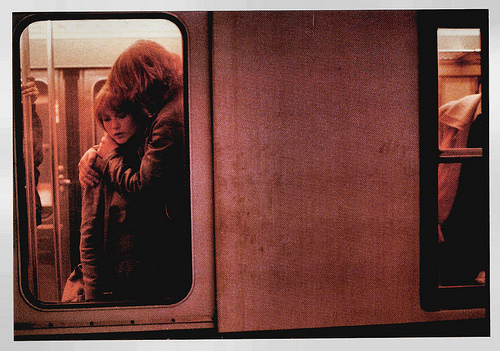
French postcard by Editions La Malibran, Nancy, in the collection Cinéma Couleur, no. MC 39. Publicity still for Loulou (Maurice Pialat, 1979) with Gérard Depardieu .
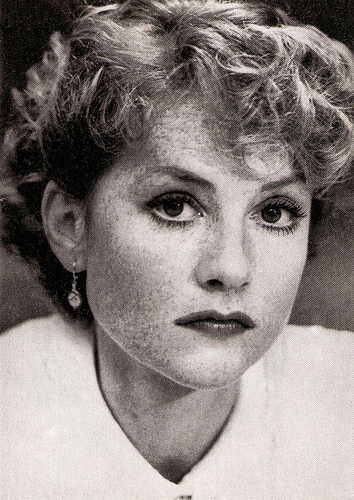
French postcard, no. 222.
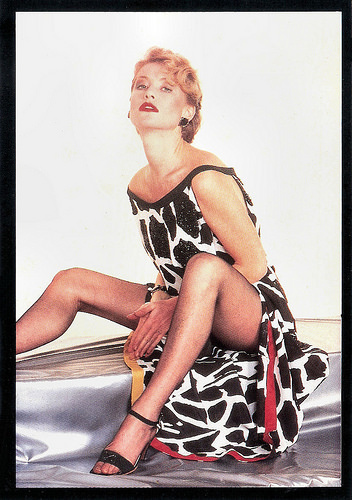
French postcard by Humour a la Carte, Paris, no. ST-159.
Greeted With A Mixture Of Boos And Applause
In 2001, Isabelle Huppert started a new interesting collaboration with Austrian film director Michael Haneke. In La Pianiste/The Piano Teacher (Michael Haneke, 2001), an adaptation of the novel by Nobel prize winner Elfriede Jelinek, she played a sexually repressed and self-destructive piano teacher, who embarks on a dark journey into sadomasochism. Regarded as one of her most impressive turns, her performance won the 2001 acting prize at the Cannes Film Festival. The film also took the Grand Prix (second prize) and was greeted with a mixture of boos and applause, provoking the main debate of the festival.
Huppert continued to work hard. In 2002, the entire cast of the popular black comedy 8 femmes/8 Women (François Ozon, 2002), also including Catherine Deneuve , Danielle Darrieux and Fanny Ardant , was voted Best Actress at the European Film Awards. The same cast won a Silver Bear for Outstanding Artistic Contribution, at the 2002 Berlin film festival.
Then Huppert was back at the set with Haneke for the disturbing Le temps du loup/The Time of the Wolf (Michael Haneke, 2003) with Béatrice Dalle . In Ma mere/My Mother (Christophe Honoré, 2004) based on a novel by George Bataille, Huppert starred as an attractive middle-aged mother who has an incestuous relationship with her teenage son (Louis Garrel).
Since Heaven's Gate, Huppert only made a few more American movies. In The Bedroom Window (Curtis Hanson, 1987) she played Steve Guttenberg’s mistress, and in Amateur (Hal Hartley, 1994) a former nun writing porn. In I [Heart] Huckabees (David O. Russell, 2004) she portrayed author Catherine Vauban, nemesis of existential detectives Dustin Hoffman and Lily Tomlin.
At the 2005 Venice film festival, Huppert received a special Lion for her role in Gabrielle (Patrice Chéreau, 2005). The following year, she reunited with Claude Chabrol for L'ivresse du pouvoir/The Comedy of Power (2006). On the Paris stage, she appeared as the suicidal Hedda Gabler, in Henrik Ibsen's play.
In 1994 she was made Chevalier (Knight) of the Ordre national du Mérite and in 2005 she was promoted to Officier (Officer). She was also made Chevalier (Knight) of the Légion d'honneur in 1999 and was promoted to Officier (Officer) in 2009. With her spouse, director Ronnie Chammah, she has three children: actress Lolita Chammah (1983), Lorenzo Chammah (1986) and Angelo Chammah (1997). Huppert likes to keep her private life private though. Her work is her main issue in interviews.
In 2012, two of her films competed for the Palme d'Or in Cannes: Amour/Love (Michael Haneke, 2012) and the South-Korean production Da-reun na-ra-e-seo/In Another Country (Sang-soo Hong, 2012). Her part as the daughter of Jean-Louis Trintignant and Emmanuelle Riva in Amour also got her another César nomination.
In Valley of Love (Guillaume Nicloux, 2015, she reunited with Gérard Depardieu . They play two famous actors who used to be a couple and had a son 25 years ago. They reunite after the son's death, and receive a letter asking them to visit five places at Death Valley, which will make the son reappear. Valley of Love was selected to compete for the Palme d'Or at the 2015 Cannes Film Festival. And now she is back in Cannes with Elle (Paul Verhoeven, 2016).
French trailer La Dentelliere/The Lacemaker (1977). Source: Berny3000 (YouTube).
Trailer Coup de torchon/Clean Slate (1981). Source: WorleyClarence (YouTube).
Trailer Amour/Love (2012). Source: MovieclipsTrailers (YouTube).
French trailer Elle (Paul Verhoeven, 2016). Source: cinémaniak (YouTube).
Sources: Stuart Jeffries (The Observer), Rebecca Flint Marx (AllMovie), Yahoo! Movies, Wikipedia and .

Romanian postcard by Casa Filmului Acin.

Romanian postcard by Casa Filmului Acin.

Romanian postcard by Casa Filmului Acin.
Casually Poisoning Her Parents
Isabelle Anne Madeleine Huppert was born in Paris in 1953 (some sources say 1955). She is the youngest of five daughters of Annick Beau, a teacher of English, and Raymond Huppert, a safe manufacturer.
At age 13, she announced her intention to be an actor, and was encouraged by her mother. She studied at the Versailles Conservatoire and later attended the CNSAD (National Conservatory of Dramatic Art of Paris).
Huppert made her film debut in Faustine et le bel été/Faustine and the Beautiful Summer (Nina Companeez, 1972). Five years later, she already had appeared in 15 films and had worked with major directors. She played Romy Schneider 's younger sister in César et Rosalie/Cesar and Rosalie (Claude Sautet, 1972).
In Bertrand Blier’s road movie Les valseuses/Going Places (1974), she played a bored teenager who runs off with three young vagabonds ( Gérard Depardieu , Patrick Dewaere and Miou-Miou). For director Otto Preminger, Huppert made her English-language debut in Rosebud (1975) starring Peter O’Toole .
Her international breakthrough came with her guileless performance as a simple, provincial girl destroyed by a summer romance with a middle-class student in La Dentelliere/The Lacemaker (Claude Goretta, 1977). For this unforgettable portrayal she was awarded with both a BAFTA award (British Academy Award) and a David di Donatello (the Italian Oscar).
At the next Cannes film festival, she won the Best Actress award for Violette Nozière (Claude Chabrol, 1978). In this true story, she portrayed a woman who scandalized France in 1933 by casually poisoning her parents. She tied the award with Jill Clayburgh.

Romanian postcard by Casa Filmului Acin. Photo: publicity still for Les soeurs Brontë/The Bronte Sisters (André Téchniné, 1979) with Marie-France Pisier as Charlotte Bronte, Isabelle Huppert as Anne Bronte, and Isabelle Adjani as Emily Brontë.

Dominique Sanda and Isabelle Huppert. Romanian postcard by Casa Filmului Acin. Publicity still for Les ailes de la colombe/The Wings of the Dove (Benoît Jacquot, 1981).
Legendary Disaster
Isabelle Huppert made her American film debut in the blockbuster Heaven's Gate (Michael Cimino, 1980), which proved to be a legendary disaster at the box office.
In France she continued to explore enigmatic and emotionally distant characters, such as an upper-class woman who is physically attracted by a young vagabond ( Gérard Depardieu ) in Loulou (Maurice Pialat, 1980), a prostitute in Sauve qui peut (la vie)/Slow Motion (Jean-Luc Godard, 1980), the mistress of Philippe Noiret ’s character in Coup de torchon/Clean Slate (Bertrand Tavernier, 1981) and a Jewish refugee in Coup de foudre/Entre nous (Diane Kurys, 1983).
She used her influence to help non-commercial projects get off the ground, like Joseph Losey's La Truite/The Trout (1982) and sister Caroline Huppert's Signé Charlotte/Sincerely, Charlotte (1984).
For her role in Une Affaire de Femmes/Story of Women (Claude Chabrol, 1988), she received the Volpi Cup for Best Actress at the Venice film festival. This time, she tied with Shirley MacLaine. She won the Volpi Cup again for her role in La Cérémonie (Claude Chabrol, 1995) as a shy but manic and homicidal post-office mistress in a French village. This time she tied the award with her co-star in that film, Sandrine Bonnaire. For La Cérémonie, she also won her only César award.
The offspring of her cinematic relationship with director Claude Chabrol also includes the widely acclaimed literary adaptation Madame Bovary (1991), the crime comedy Rien ne va plus/The Swindle (1997), and the thriller Merci pour le chocolat/Thanks for the Chocolate (2000).
Stuart Jeffries in The Observer about their cooperation: “Huppert has excelled in the spiteful, the nasty, the unpleasant and - regularly - the murderous. More than that, she carries herself with imperious intelligence, and thus seems to be self-conscious about her own wickedness. No doubt that is why Chabrol has cast her so often. He's interested in guilt, manipulativeness and shame - all of which she loves portraying.”

French postcard by Editions La Malibran, Nancy, in the collection Cinéma Couleur, no. MC 39. Publicity still for Loulou (Maurice Pialat, 1979) with Gérard Depardieu .

French postcard, no. 222.

French postcard by Humour a la Carte, Paris, no. ST-159.
Greeted With A Mixture Of Boos And Applause
In 2001, Isabelle Huppert started a new interesting collaboration with Austrian film director Michael Haneke. In La Pianiste/The Piano Teacher (Michael Haneke, 2001), an adaptation of the novel by Nobel prize winner Elfriede Jelinek, she played a sexually repressed and self-destructive piano teacher, who embarks on a dark journey into sadomasochism. Regarded as one of her most impressive turns, her performance won the 2001 acting prize at the Cannes Film Festival. The film also took the Grand Prix (second prize) and was greeted with a mixture of boos and applause, provoking the main debate of the festival.
Huppert continued to work hard. In 2002, the entire cast of the popular black comedy 8 femmes/8 Women (François Ozon, 2002), also including Catherine Deneuve , Danielle Darrieux and Fanny Ardant , was voted Best Actress at the European Film Awards. The same cast won a Silver Bear for Outstanding Artistic Contribution, at the 2002 Berlin film festival.
Then Huppert was back at the set with Haneke for the disturbing Le temps du loup/The Time of the Wolf (Michael Haneke, 2003) with Béatrice Dalle . In Ma mere/My Mother (Christophe Honoré, 2004) based on a novel by George Bataille, Huppert starred as an attractive middle-aged mother who has an incestuous relationship with her teenage son (Louis Garrel).
Since Heaven's Gate, Huppert only made a few more American movies. In The Bedroom Window (Curtis Hanson, 1987) she played Steve Guttenberg’s mistress, and in Amateur (Hal Hartley, 1994) a former nun writing porn. In I [Heart] Huckabees (David O. Russell, 2004) she portrayed author Catherine Vauban, nemesis of existential detectives Dustin Hoffman and Lily Tomlin.
At the 2005 Venice film festival, Huppert received a special Lion for her role in Gabrielle (Patrice Chéreau, 2005). The following year, she reunited with Claude Chabrol for L'ivresse du pouvoir/The Comedy of Power (2006). On the Paris stage, she appeared as the suicidal Hedda Gabler, in Henrik Ibsen's play.
In 1994 she was made Chevalier (Knight) of the Ordre national du Mérite and in 2005 she was promoted to Officier (Officer). She was also made Chevalier (Knight) of the Légion d'honneur in 1999 and was promoted to Officier (Officer) in 2009. With her spouse, director Ronnie Chammah, she has three children: actress Lolita Chammah (1983), Lorenzo Chammah (1986) and Angelo Chammah (1997). Huppert likes to keep her private life private though. Her work is her main issue in interviews.
In 2012, two of her films competed for the Palme d'Or in Cannes: Amour/Love (Michael Haneke, 2012) and the South-Korean production Da-reun na-ra-e-seo/In Another Country (Sang-soo Hong, 2012). Her part as the daughter of Jean-Louis Trintignant and Emmanuelle Riva in Amour also got her another César nomination.
In Valley of Love (Guillaume Nicloux, 2015, she reunited with Gérard Depardieu . They play two famous actors who used to be a couple and had a son 25 years ago. They reunite after the son's death, and receive a letter asking them to visit five places at Death Valley, which will make the son reappear. Valley of Love was selected to compete for the Palme d'Or at the 2015 Cannes Film Festival. And now she is back in Cannes with Elle (Paul Verhoeven, 2016).
French trailer La Dentelliere/The Lacemaker (1977). Source: Berny3000 (YouTube).
Trailer Coup de torchon/Clean Slate (1981). Source: WorleyClarence (YouTube).
Trailer Amour/Love (2012). Source: MovieclipsTrailers (YouTube).
French trailer Elle (Paul Verhoeven, 2016). Source: cinémaniak (YouTube).
Sources: Stuart Jeffries (The Observer), Rebecca Flint Marx (AllMovie), Yahoo! Movies, Wikipedia and .
Published on May 10, 2016 22:00
May 9, 2016
Dominique Wilms
Belgian actress Dominique Wilms (1930) was the glamorous and sexy femme fatale of many French action films of the 1950s and 1960s, often opposite Eddie Constantine. Many of these ‘Euro Noirs’ are B-films with a strong cult and trash factor.
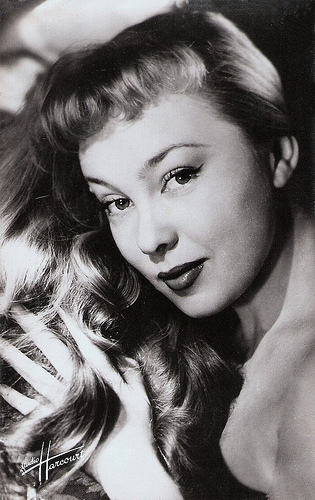
French postcard by Editions du Globe, Paris, no. 233. Photo: Studio Harcourt.
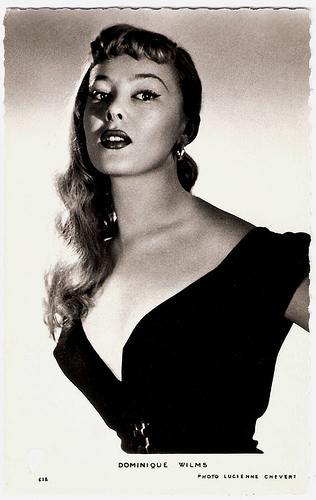
French postcard by Editions P.I., Paris, no. 28G. Photo: Lucienne Chevert.
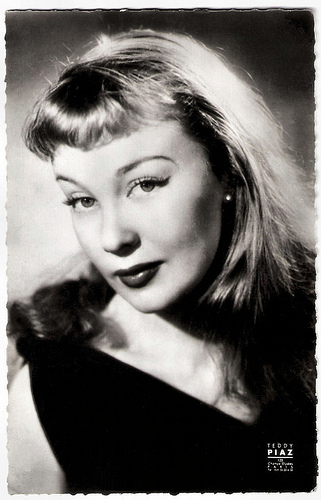
French postcard by Editions du Globe, Paris, no. 396. Photo: Teddy Piaz.
Ruthless vamp and calculating luxury bitch
Dominique Wilms was born Claudine Maria Célina Wilmes in Montignies-sur-Sambre, Belgium, in 1930. Wilms studied at the Ecole des Beaux-Arts in Paris, and subsequently, she became a model.
Director Edmond T. Gréville discovered her and recommended her to his younger colleague Bernard Borderie for the femme fatale role in the action film La môme vert de gris/Poison Ivy (Bernard Borderie, 1953), based on a novel by Peter Cheney. It became a sensational success and her breakthrough.
La môme vert de gris would be the first of a popular series of French action films starring Eddie Constantine as Lemmy Caution, the two-fisted FBI agent created by novelist Peter Cheney. Lemmy Caution can be seen as the precursor of James Bond.
At IMDb , reviewer Kuciak writes: “The book was written in 1937, this movie made in 1953, the birth of James Bond in Casino Royale. Like Bond, he flirts with the secretary before going to see his boss, he drinks whiskey, were as Bond drinks Martinis. He does not bed women, but he finds any way he can kiss a woman. Even the ending, where he is with a woman, will remind one of James Bond Films, as they are in no hurry to meet up with the police. What was more striking was that this film almost appeared to be a rehearsal for Thunderball.”
Eddie Constantine and Wilms were reunited in the third Lemmy Caution adventure, Les Femmes s'en balancent/Dames Don’t Care (Bernard Borderie, 1954). In this outing, Lemmy is on the trail of a counterfeiting gang and somehow or other, the mission requires him to dally with such beauties as Wilms and Nadia Gray , who may or may not be mixed up in a blackmail scheme.
Dominique Wilms became the French equivalent of Veronica Lake, the blonde star of the American Film Noir. She would play the ruthless vamp and calculating luxury bitch in Euro Noirs again and again.
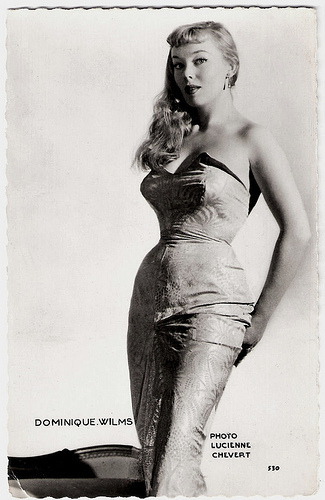
French postcard by Editions P.I., Paris, no. 21G. Photo: Lucienne Chevert.
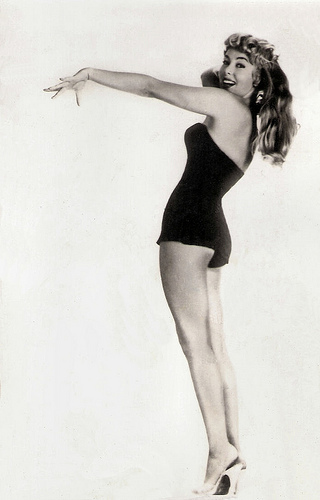
Yugoslavian postcard by Studio Sombor. Photo: Sam Lévin.
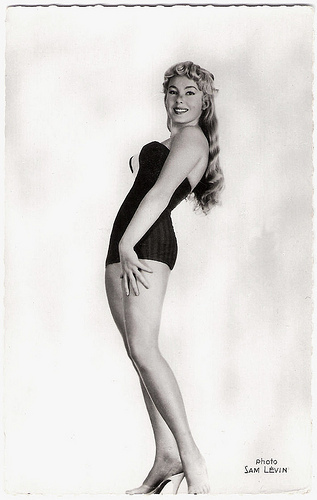
French postcard by Editions du Globe, Paris, no. 394. Photo: Sam Lévin.
A Potential Death Trap
A big hit on the European film festival circuit was the thriller Les Assassins Du Dimanche/Every Second Counts (Alex Joffe, 1957). A garage mechanic ( Jean-Marc Thibault ) returns a car to its owner on a Sunday morning, but unbeknownst to him the steering mechanism has not been properly tightened. When the mechanic realises that the car is a potential death trap, he desperately tries to contact the owner.
Wilms appeared again opposite Constantine in Le Grand Bluff/The Big Bluff (Patrice Dally, 1957). In La rivière des 3 jonques/The River of Three Junks (André Pergament, 1957), Jean Gaven was her leading man. The two co-stars would marry later that same year. The next year they starred together again in Les aventuriers du Mékong/Adventures in Indochina (Jean Bastia, 1958).
Suggested by author Françoise Sagan, Otto Preminger chose Wilms for the part of Elsa in the film adaptation of Sagan’s bestseller Bonjour Tristesse (Otto Preminger, 1957), but she refused because she had to stay for six months in the USA to perfect her English. The role was ultimately played by Mylène Demongeot .
Thus Wilms continued to appear in French action films and comedies. In the 1960s, when the roles in French detective films dried up, she appeared also in German and Italian films. Again opposite Eddie Constantine, she starred in the German-French production Bomben auf Monte Carlo/Bombs on Monte Carlo (Georg Jacoby, 1960).
Wilms played a showgirl who marries a farmer (Antonio Cifariello) in the Argentinian-Italian western Questo Amore Ai Confini Del Mondo/This Love at the End of the World (Giuseppe Maria Scotese, 1960). In 1963 she was Queen Astrid in the Peplum (epic Italian costume drama) Giulio Cesare, il conquistatore delle Gallie/Caesar the Conqueror (Amerigo Anton, Tanio Boccia, 1963) with Rik Battaglia and Cameron Mitchell as Julius Caesar.
In the French-Italian spy film Banco à Bangkok (pour OSS 117)/Shadow of Evil (André Hunebelle, 1964) she co-starred with Kerwin Matthews and Pier Angeli . She also played in television films and series.
Finally, she left the cinema and devoted herself to her first love: painting. She studied art history at the Ecole du Louvre for four years. Another hobby is the restoration of art objects. Her husband, Jean Gaven passed away in 2014.
Scene from La môme vert de gris/Poison Ivy (1953). Sorry, no subtitles. Source: Classic movies library (YouTube).
Original French trailer for Banco à Bangkok (pour OSS 117)/Shadow of Evil (1964). Sorry, no subtitles. Source: Gaumont (YouTube).
Sources: Hal Erickson (AllMovie), Kuciak (IMDb), Wikipedia (English, German, French) and .

French postcard by Editions du Globe, Paris, no. 233. Photo: Studio Harcourt.

French postcard by Editions P.I., Paris, no. 28G. Photo: Lucienne Chevert.

French postcard by Editions du Globe, Paris, no. 396. Photo: Teddy Piaz.
Ruthless vamp and calculating luxury bitch
Dominique Wilms was born Claudine Maria Célina Wilmes in Montignies-sur-Sambre, Belgium, in 1930. Wilms studied at the Ecole des Beaux-Arts in Paris, and subsequently, she became a model.
Director Edmond T. Gréville discovered her and recommended her to his younger colleague Bernard Borderie for the femme fatale role in the action film La môme vert de gris/Poison Ivy (Bernard Borderie, 1953), based on a novel by Peter Cheney. It became a sensational success and her breakthrough.
La môme vert de gris would be the first of a popular series of French action films starring Eddie Constantine as Lemmy Caution, the two-fisted FBI agent created by novelist Peter Cheney. Lemmy Caution can be seen as the precursor of James Bond.
At IMDb , reviewer Kuciak writes: “The book was written in 1937, this movie made in 1953, the birth of James Bond in Casino Royale. Like Bond, he flirts with the secretary before going to see his boss, he drinks whiskey, were as Bond drinks Martinis. He does not bed women, but he finds any way he can kiss a woman. Even the ending, where he is with a woman, will remind one of James Bond Films, as they are in no hurry to meet up with the police. What was more striking was that this film almost appeared to be a rehearsal for Thunderball.”
Eddie Constantine and Wilms were reunited in the third Lemmy Caution adventure, Les Femmes s'en balancent/Dames Don’t Care (Bernard Borderie, 1954). In this outing, Lemmy is on the trail of a counterfeiting gang and somehow or other, the mission requires him to dally with such beauties as Wilms and Nadia Gray , who may or may not be mixed up in a blackmail scheme.
Dominique Wilms became the French equivalent of Veronica Lake, the blonde star of the American Film Noir. She would play the ruthless vamp and calculating luxury bitch in Euro Noirs again and again.

French postcard by Editions P.I., Paris, no. 21G. Photo: Lucienne Chevert.

Yugoslavian postcard by Studio Sombor. Photo: Sam Lévin.

French postcard by Editions du Globe, Paris, no. 394. Photo: Sam Lévin.
A Potential Death Trap
A big hit on the European film festival circuit was the thriller Les Assassins Du Dimanche/Every Second Counts (Alex Joffe, 1957). A garage mechanic ( Jean-Marc Thibault ) returns a car to its owner on a Sunday morning, but unbeknownst to him the steering mechanism has not been properly tightened. When the mechanic realises that the car is a potential death trap, he desperately tries to contact the owner.
Wilms appeared again opposite Constantine in Le Grand Bluff/The Big Bluff (Patrice Dally, 1957). In La rivière des 3 jonques/The River of Three Junks (André Pergament, 1957), Jean Gaven was her leading man. The two co-stars would marry later that same year. The next year they starred together again in Les aventuriers du Mékong/Adventures in Indochina (Jean Bastia, 1958).
Suggested by author Françoise Sagan, Otto Preminger chose Wilms for the part of Elsa in the film adaptation of Sagan’s bestseller Bonjour Tristesse (Otto Preminger, 1957), but she refused because she had to stay for six months in the USA to perfect her English. The role was ultimately played by Mylène Demongeot .
Thus Wilms continued to appear in French action films and comedies. In the 1960s, when the roles in French detective films dried up, she appeared also in German and Italian films. Again opposite Eddie Constantine, she starred in the German-French production Bomben auf Monte Carlo/Bombs on Monte Carlo (Georg Jacoby, 1960).
Wilms played a showgirl who marries a farmer (Antonio Cifariello) in the Argentinian-Italian western Questo Amore Ai Confini Del Mondo/This Love at the End of the World (Giuseppe Maria Scotese, 1960). In 1963 she was Queen Astrid in the Peplum (epic Italian costume drama) Giulio Cesare, il conquistatore delle Gallie/Caesar the Conqueror (Amerigo Anton, Tanio Boccia, 1963) with Rik Battaglia and Cameron Mitchell as Julius Caesar.
In the French-Italian spy film Banco à Bangkok (pour OSS 117)/Shadow of Evil (André Hunebelle, 1964) she co-starred with Kerwin Matthews and Pier Angeli . She also played in television films and series.
Finally, she left the cinema and devoted herself to her first love: painting. She studied art history at the Ecole du Louvre for four years. Another hobby is the restoration of art objects. Her husband, Jean Gaven passed away in 2014.
Scene from La môme vert de gris/Poison Ivy (1953). Sorry, no subtitles. Source: Classic movies library (YouTube).
Original French trailer for Banco à Bangkok (pour OSS 117)/Shadow of Evil (1964). Sorry, no subtitles. Source: Gaumont (YouTube).
Sources: Hal Erickson (AllMovie), Kuciak (IMDb), Wikipedia (English, German, French) and .
Published on May 09, 2016 22:00
May 8, 2016
Leda Gys
Versatile actress Leda Gys (1892-1957) was the only Italian diva who never played vamp roles and the only one whose career lasted until the advent of sound films. She starred in some 80 dramas, comedies, action thrillers and even westerns of the Italian and Spanish silent cinema. Her claim to fame came with the film Christus (1916), shot in Egypt and Palestine, where Gys performed the Madonna.
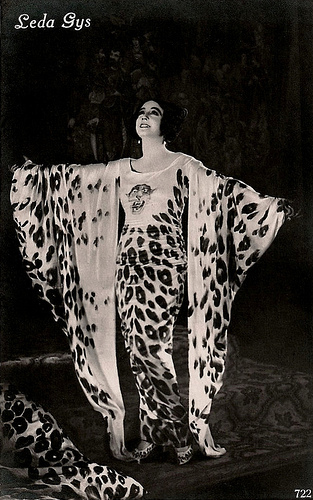
Italian postcard by Ed. A. Traldi, Milano (Milan), no. 722.
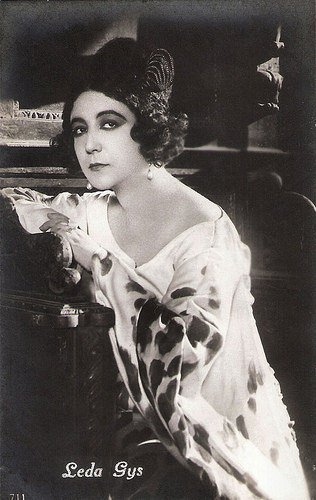
Italian postcard by Ed. A. Traldi, Milano, no. 711.
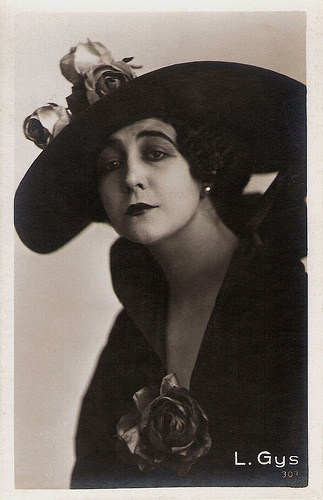
Italian postcard by Ed. G. Vettori, Bologna, no. 303.
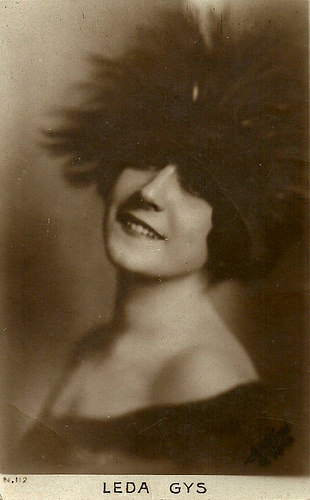
Italian postcard by Edit. Soc. Anon. It. Bettini, Roma, no. 112.
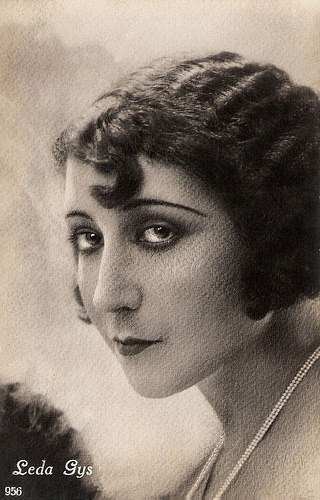
Italian postcard by Ed. A. Traldi, Milano, no. 956.
Madonna
Leda Gys was born as Giselda Ilardi in Roma (Rome), Italy, in 1892.
Her lover, the Roman poet Carlo Alberto Trilussa introduced young Giselda to the Cines film studios in 1912. He also gave her her artist's name Leda Gys, by anagrammatising her Christian name, Giselda. Her film debut was the short silent Cines drama Fior d'amore e fior di morte/Flower of Love and Flower of Death (1912) with Amleto Novelli .
Gys quickly rose to leads in films like L'histoire d'un Pierrot/Pierrot the Prodigal (Baldassarre Negroni, 1914) with Francesca Bertini , L'amazzone mascherata/The Masked Amazon (Baldassarre Negroni, 1914) again with Bertini and with Emilio Ghione , La marcia nuziale/The Wedding March (Carmine Gallone, 1915) with Lyda Borelli , Maschera di mistero/Mask of Mystery (Mario Caserini, 1915) and La morta del lago/A Fatal Fascination (Enrico Guazzoni, 1915) with Pina Menichelli .
Italian-American film historian Angela Dalle Vacche writes in the Encyclopedia Of Early Cinema : "Working for both Cines and its branch Celio, between 1913 and 1914, she sharpened her skills in some two dozen short—or medium-length films directed by Enrico Guazzoni and others. It was then that Gys began to develop a personal screen type based on American stars, combining the girl-next-door innocence of Mary Pickford and the suffering pathos of Lilian Gish."
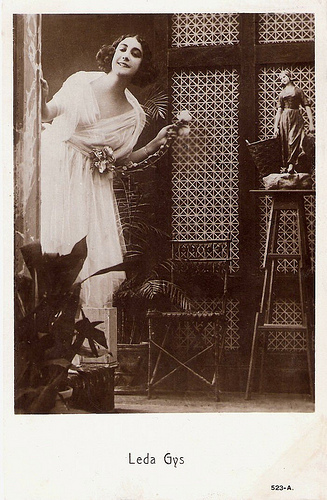
Vintage postcard, no. 523A, sent by mail from Belgium to the Netherlands in 1928.
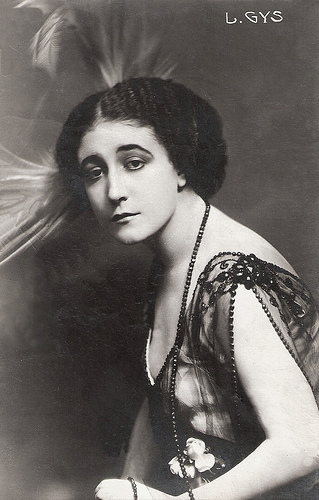
Vintage Italian postcard.
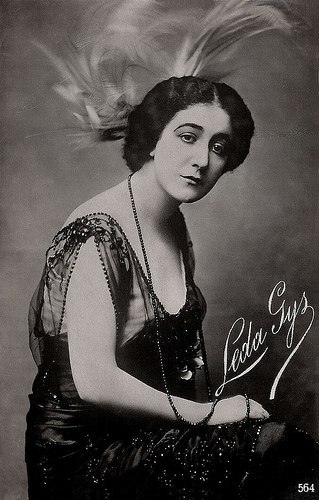
Italian postcard by Ed. A. Traldi, Milano, no. 564.
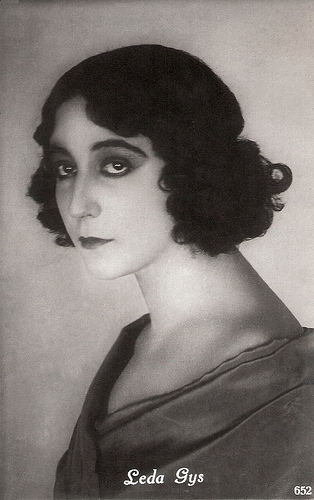
Italian postcard by Ed. Romeo Biagi, Bologna, no. 652.
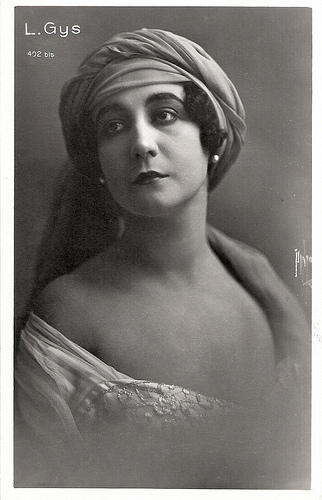
Italian postcard by Ed. Vettori, Bologna, no. 402 bis. Photo: Foto Pinto, Roma.
Neapolitan Dramas and Comedies
The versatile Leda Gys appeared in all kind of genres: drama, comedy, action thrillers and even westerns. Often she played pathetic roles of the romantic and innocent young woman, victim of loose mothers, unfaithful husbands, adventurers etc.
Her claim to fame came with Christus/Christ (Giulio Antamoro, 1916), a religious epic shot in Egypt and Palestine. Gys performed the Madonna and Alberto Pasquali appeared as Jesus Christ.
Various films in Spain followed, such as Flor de otoño/Autumn Flowers (Mario Caserini, 1916) with Maria Caserini, which lead to the belief afterwards that she was a Spanish actress.
From the late 1910s on, Gys performed in the Neapolitan dramas and comedies, produced by the Neapolitan producer and Gys' husband Gustavo Lombardo. Lombardo was inspired by American cinema and transposed the American modern style to Italian cinema, thus mixing Gys's characters with sentiment or wit.
These films like I figli di nessuno/Nobody's Children (Ubaldo Maria del Colle, 1921) and Napoli è una canzone/Naples is a Song (Eugenio Perego, 1927), appealed to Italian emigrants in North and South America thanks to their shots of Naples and surroundings, their references to Neapolitan regional theatre and their intertitles in Neapolitan dialect.
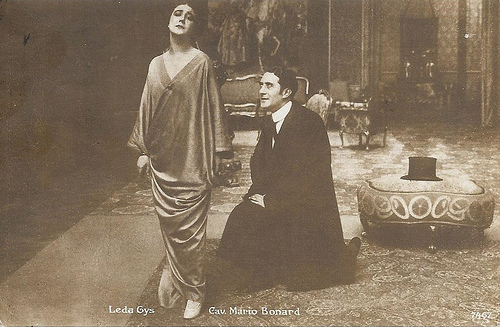
French postcard, no. 7467. Photo: publicity still for La pantomima della morte/The pantomime of death (Mario Caserini, 1915) with Mario Bonard. Collection: Didier Hanson.
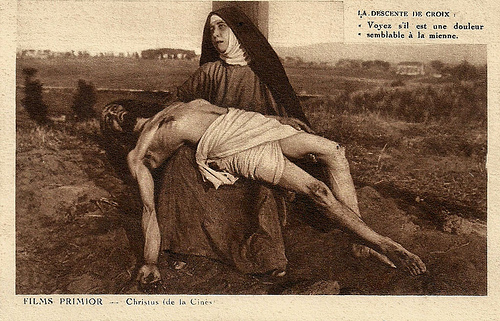
French postcard by J. Mayer, graveur, Paris. Photo: Films Primior, Paris. The Pietà with Jesus (Alberto Pasquali) and Mary (Leda Gys), from the silent epic Christus (Giulio Antamoro, 1916).
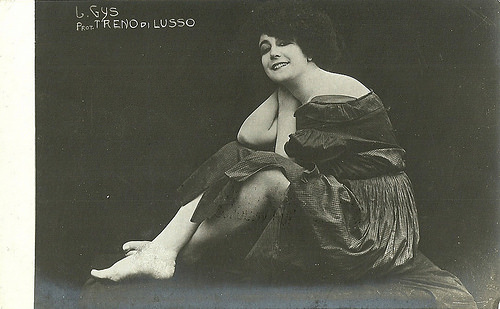
Italian postcard. Unknown editor. Leda Gys as protagonist of the film Treno di lusso (Mario Bonnard, 1917).
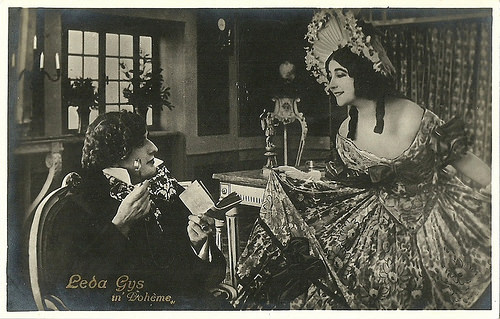
Italian postcard by G.B. Falci, Milano, no. 300. Photo: Leda Gys as Mimì in La Bohème (Amleto Palermi, 1917).
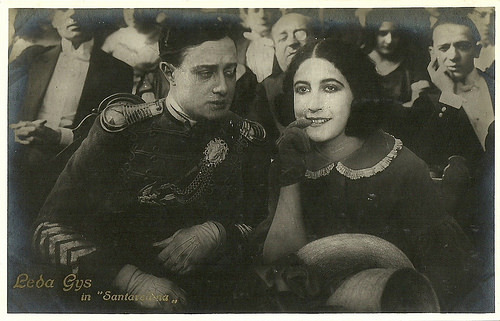
Italian postcard by G.B. Falci, Milano, no. 322. Photo: Leda Gys in Santarellina (Eugenio Perego, 1923).
Diva Dolorosa
Throughout the 1920s Leda Gys did light-hearted romantic comedies directed by Eugenio Perego.
She also worked in France, where she made Esclave/Slave (Georges Monca, Rose Pansini, 1922) with the young Charles Boyer .
In 1929 she appeared in her last films, the Titanus productions Mi chiamano Mimì Rondine/Rondine (Eugenio Perego, 1929) with Adele Farulli, and La signorina Chicchiricchì/Miss Chicchiricchì (Eugenio Perego, 1929) with Silvio Orsini.
Just before the advent of the sound film, she withdrew from the cinema to take care of her son, Goffredo Lombardo. In the post-war years Goffredo would be the producer of Titanus Film, the company founded by his father Gustavo Lombardo in 1908.
Leda Gys died in Rome in 1957. She was 65. In 1999, Gys was one of the divas of the silent Italian cinema, who were featured by Peter Delpeut in his beautiful compilation film Diva Dolorosa .
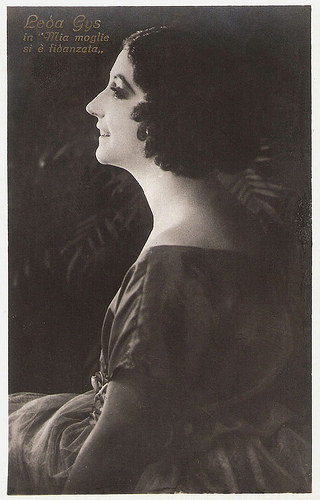
Italian postcard by G.B. Falci Editore, Milano, no. 309. Photo: publicity still for Mia moglie si è fidanzata/My wife got engaged (Gero Zambuto, 1921).
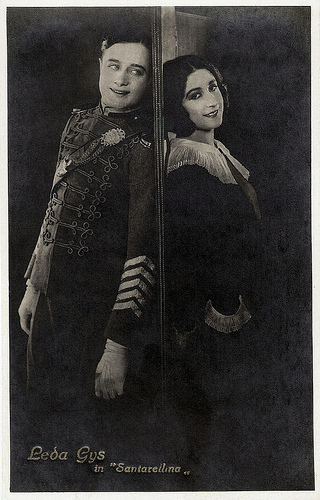
Italian postcard by G.B. Falci, Milano, no. 303. Photo: publicity still for Santarellina (Eugenio Perego, 1923) with Silvio Orsini.
Histoire d'un Pierrot (Baldassarre Negroni, 1913). Source: Enrico Giacovelli (YouTube).
Christus (Giulio Antammoro, 1916). Source: The Great Classics (YouTube).
Clip from Diva Dolorosa (1999). Source: TheStat01 (YouTube). NB. The clip is without Leda Gys.
Sources: Vittorio Martinelli (Le dive del silenzio), Angela Dalle Vacche (Encyclopedia Of Early Cinema), Wikipedia (Italian) and .

Italian postcard by Ed. A. Traldi, Milano (Milan), no. 722.

Italian postcard by Ed. A. Traldi, Milano, no. 711.

Italian postcard by Ed. G. Vettori, Bologna, no. 303.

Italian postcard by Edit. Soc. Anon. It. Bettini, Roma, no. 112.

Italian postcard by Ed. A. Traldi, Milano, no. 956.
Madonna
Leda Gys was born as Giselda Ilardi in Roma (Rome), Italy, in 1892.
Her lover, the Roman poet Carlo Alberto Trilussa introduced young Giselda to the Cines film studios in 1912. He also gave her her artist's name Leda Gys, by anagrammatising her Christian name, Giselda. Her film debut was the short silent Cines drama Fior d'amore e fior di morte/Flower of Love and Flower of Death (1912) with Amleto Novelli .
Gys quickly rose to leads in films like L'histoire d'un Pierrot/Pierrot the Prodigal (Baldassarre Negroni, 1914) with Francesca Bertini , L'amazzone mascherata/The Masked Amazon (Baldassarre Negroni, 1914) again with Bertini and with Emilio Ghione , La marcia nuziale/The Wedding March (Carmine Gallone, 1915) with Lyda Borelli , Maschera di mistero/Mask of Mystery (Mario Caserini, 1915) and La morta del lago/A Fatal Fascination (Enrico Guazzoni, 1915) with Pina Menichelli .
Italian-American film historian Angela Dalle Vacche writes in the Encyclopedia Of Early Cinema : "Working for both Cines and its branch Celio, between 1913 and 1914, she sharpened her skills in some two dozen short—or medium-length films directed by Enrico Guazzoni and others. It was then that Gys began to develop a personal screen type based on American stars, combining the girl-next-door innocence of Mary Pickford and the suffering pathos of Lilian Gish."

Vintage postcard, no. 523A, sent by mail from Belgium to the Netherlands in 1928.

Vintage Italian postcard.

Italian postcard by Ed. A. Traldi, Milano, no. 564.

Italian postcard by Ed. Romeo Biagi, Bologna, no. 652.

Italian postcard by Ed. Vettori, Bologna, no. 402 bis. Photo: Foto Pinto, Roma.
Neapolitan Dramas and Comedies
The versatile Leda Gys appeared in all kind of genres: drama, comedy, action thrillers and even westerns. Often she played pathetic roles of the romantic and innocent young woman, victim of loose mothers, unfaithful husbands, adventurers etc.
Her claim to fame came with Christus/Christ (Giulio Antamoro, 1916), a religious epic shot in Egypt and Palestine. Gys performed the Madonna and Alberto Pasquali appeared as Jesus Christ.
Various films in Spain followed, such as Flor de otoño/Autumn Flowers (Mario Caserini, 1916) with Maria Caserini, which lead to the belief afterwards that she was a Spanish actress.
From the late 1910s on, Gys performed in the Neapolitan dramas and comedies, produced by the Neapolitan producer and Gys' husband Gustavo Lombardo. Lombardo was inspired by American cinema and transposed the American modern style to Italian cinema, thus mixing Gys's characters with sentiment or wit.
These films like I figli di nessuno/Nobody's Children (Ubaldo Maria del Colle, 1921) and Napoli è una canzone/Naples is a Song (Eugenio Perego, 1927), appealed to Italian emigrants in North and South America thanks to their shots of Naples and surroundings, their references to Neapolitan regional theatre and their intertitles in Neapolitan dialect.

French postcard, no. 7467. Photo: publicity still for La pantomima della morte/The pantomime of death (Mario Caserini, 1915) with Mario Bonard. Collection: Didier Hanson.

French postcard by J. Mayer, graveur, Paris. Photo: Films Primior, Paris. The Pietà with Jesus (Alberto Pasquali) and Mary (Leda Gys), from the silent epic Christus (Giulio Antamoro, 1916).

Italian postcard. Unknown editor. Leda Gys as protagonist of the film Treno di lusso (Mario Bonnard, 1917).

Italian postcard by G.B. Falci, Milano, no. 300. Photo: Leda Gys as Mimì in La Bohème (Amleto Palermi, 1917).

Italian postcard by G.B. Falci, Milano, no. 322. Photo: Leda Gys in Santarellina (Eugenio Perego, 1923).
Diva Dolorosa
Throughout the 1920s Leda Gys did light-hearted romantic comedies directed by Eugenio Perego.
She also worked in France, where she made Esclave/Slave (Georges Monca, Rose Pansini, 1922) with the young Charles Boyer .
In 1929 she appeared in her last films, the Titanus productions Mi chiamano Mimì Rondine/Rondine (Eugenio Perego, 1929) with Adele Farulli, and La signorina Chicchiricchì/Miss Chicchiricchì (Eugenio Perego, 1929) with Silvio Orsini.
Just before the advent of the sound film, she withdrew from the cinema to take care of her son, Goffredo Lombardo. In the post-war years Goffredo would be the producer of Titanus Film, the company founded by his father Gustavo Lombardo in 1908.
Leda Gys died in Rome in 1957. She was 65. In 1999, Gys was one of the divas of the silent Italian cinema, who were featured by Peter Delpeut in his beautiful compilation film Diva Dolorosa .

Italian postcard by G.B. Falci Editore, Milano, no. 309. Photo: publicity still for Mia moglie si è fidanzata/My wife got engaged (Gero Zambuto, 1921).

Italian postcard by G.B. Falci, Milano, no. 303. Photo: publicity still for Santarellina (Eugenio Perego, 1923) with Silvio Orsini.
Histoire d'un Pierrot (Baldassarre Negroni, 1913). Source: Enrico Giacovelli (YouTube).
Christus (Giulio Antammoro, 1916). Source: The Great Classics (YouTube).
Clip from Diva Dolorosa (1999). Source: TheStat01 (YouTube). NB. The clip is without Leda Gys.
Sources: Vittorio Martinelli (Le dive del silenzio), Angela Dalle Vacche (Encyclopedia Of Early Cinema), Wikipedia (Italian) and .
Published on May 08, 2016 22:00
May 7, 2016
Marga Barbu
Marga Barbu also known as Margareta-Yvonne Barbu (1929-2009) was a Romanian stage and film actress. She became a star with the historical adventure film Haiducii/Outlaws (Dinu Cocea, 1966) and appeared in many Romanian features and TV films of the 1960s and 1970s.
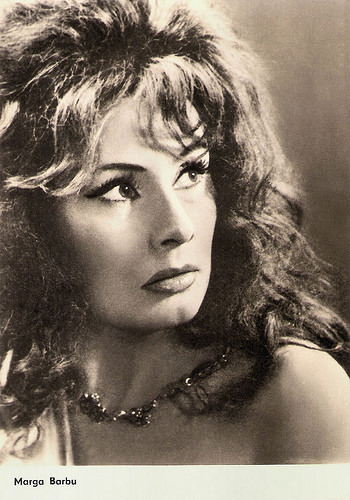
East-German postcard by VEB Progress Filmvertrieb, Berlin, no. 2701, 1966. Publicity still for Haiducii/The Outlaws (Dinu Cocea, 1966).
A Page of modern Romanian history
Marga Barbu was born as Margareta-Yvonne Butuc in 1929 in Ocna Şugatag, Romania. When she was 14, her family moved to Romania’s capital, Bucharest. Marga’s first great love was dancing and she would have done anything to follow her mother’s footsteps, who had been a ballerina in Vienna.
Marga was hired by the Romanian Opera, but the medical test relevealed she had a heart condition, which made her drop the idea of a dance career. After following various classes in acting, dance and philosophy, she ultimately choose for acting. In 1950 she graduated from the Theatre Institute in Bucharest.
She made her film debut in Nepotii gornistului/The Bugler's Grandsons (Dinu Negreanu, 1953), with her later husband Constantin Codrescu and Iurie Darie . In the following years, she appeared in Romanian films like Rasare soarele/The Sun Rises (Dinu Negreanu, 1954) again with Codrescu and Darie, and the war film Vultur 101/Eagle 101 (Andrei Calarasu, 1957) with Ion Besoiu.
After an intermission of several years, she returned to the cinema with Procesul alb/White Trial (Iulian Mihu, 1965), written by her then husband Eugen Barbu. She is especially known in Romania for her role as Anita in the historical adventure film Haiducii/Outlaws (Dinu Cocea, 1966) and its many sequels. As IMDb-reviewer Armand writes: “Almost remarkable theatrical, admirable work for its period, mixture of adventure story and romance using a page of modern Romanian history (...) with Marga Barbu in a role which defines her career.”
She had other successes with the comedy La portile pamîntului/At the Gates of the Earth (Geo Saizescu, 1966) with George Constantin and with Dragostea începe vinery/Love Begins on Friday (Virgil Calotescu, 1972).
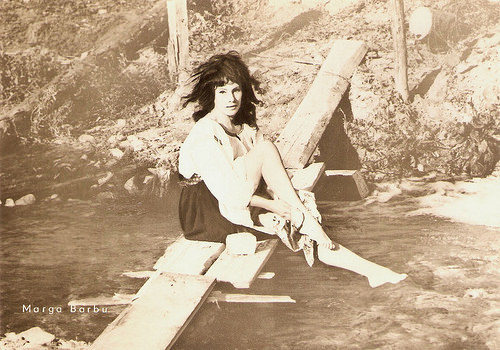
East-German postcard by VEB Progress Filmvertrieb, Berlin, no. 196/71, 1971.
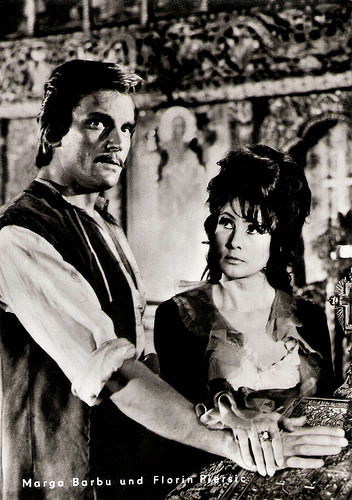
East-German postcard by VEB Progress Filmvertrieb, Berlin, no. 71/72, 1972. Publicity still for Zestrea domnitei Ralu/The Dowry of Lady Ralu (Dinu Cocea, 1972) with Florin Piersic .
A Robin Hood-like outlaw in Romania
One of Marga Barbu’s best known films is the crime film Ultimul cartuş/The Last Bullet (1973), directed by Sergiu Nicolaescu. The cast included other well known Romanian stars like Amza Pellea, Ion Besoiu and Jean Constantin.
She also starred in Tatal risipitor/The Podrigal Father (Adrian Petringenaru, 1974) with Toma Caragiu. Another success that lead to several sequels was Trandafirul galben/The Yellow Rose (Doru Nastase, 1982) about a Robin Hood-like outlaw in Romania of the 1800s, in which she starred as Agata Slatineanu.
Twice, for her roles in Bietul Ioanide/Poor Ioanide (Dan Pita, 1980) and in Domnisoara Aurica/Miss Aurica (Serban Marinescu, 1986), she was awarded the ACIN Best Actress award (Romania’s most prestigious film award). Her last film was Lacrima cerului/Tear of Heaven (Adrian Istratescu Lener, 1989).
Besides her impressive career in the cinema, Barbu was also a noted stage actress. From 1952 until her retirement in 1993 she worked for the Nottara Theatre. Her favourite role in the theatre was Cleopatra in the play Antony and Cleopatra by William Shakespeare. She was also a beloved comedienne.
In 2004, President Ion Iliescu decorated her with the National Order for Faithful Service in the rank of Knight. Marga Barbu died in 2009 in Bucharest, Romania, at the age of 80. She was married three times. Her first husband was a textile engineer in Ploiesti. She then married actor Constantin Codrescu. Finally, she was married for over 30 years with writer Eugen Barbu.
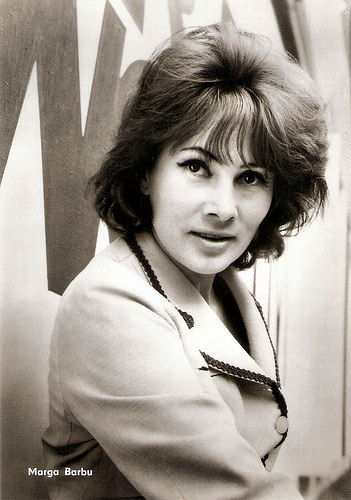
East-German postcard by VEB Progress Filmvertrieb, Berlin, no. 74/69, 1969. Photo: Balinski.
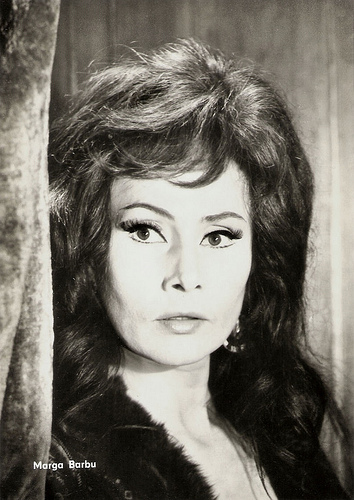
East-German postcard by VEB Progress Filmvertrieb, Berlin, no. 141/69, 1969.
Sources: Wikipedia (Romanian and English) and .

East-German postcard by VEB Progress Filmvertrieb, Berlin, no. 2701, 1966. Publicity still for Haiducii/The Outlaws (Dinu Cocea, 1966).
A Page of modern Romanian history
Marga Barbu was born as Margareta-Yvonne Butuc in 1929 in Ocna Şugatag, Romania. When she was 14, her family moved to Romania’s capital, Bucharest. Marga’s first great love was dancing and she would have done anything to follow her mother’s footsteps, who had been a ballerina in Vienna.
Marga was hired by the Romanian Opera, but the medical test relevealed she had a heart condition, which made her drop the idea of a dance career. After following various classes in acting, dance and philosophy, she ultimately choose for acting. In 1950 she graduated from the Theatre Institute in Bucharest.
She made her film debut in Nepotii gornistului/The Bugler's Grandsons (Dinu Negreanu, 1953), with her later husband Constantin Codrescu and Iurie Darie . In the following years, she appeared in Romanian films like Rasare soarele/The Sun Rises (Dinu Negreanu, 1954) again with Codrescu and Darie, and the war film Vultur 101/Eagle 101 (Andrei Calarasu, 1957) with Ion Besoiu.
After an intermission of several years, she returned to the cinema with Procesul alb/White Trial (Iulian Mihu, 1965), written by her then husband Eugen Barbu. She is especially known in Romania for her role as Anita in the historical adventure film Haiducii/Outlaws (Dinu Cocea, 1966) and its many sequels. As IMDb-reviewer Armand writes: “Almost remarkable theatrical, admirable work for its period, mixture of adventure story and romance using a page of modern Romanian history (...) with Marga Barbu in a role which defines her career.”
She had other successes with the comedy La portile pamîntului/At the Gates of the Earth (Geo Saizescu, 1966) with George Constantin and with Dragostea începe vinery/Love Begins on Friday (Virgil Calotescu, 1972).

East-German postcard by VEB Progress Filmvertrieb, Berlin, no. 196/71, 1971.

East-German postcard by VEB Progress Filmvertrieb, Berlin, no. 71/72, 1972. Publicity still for Zestrea domnitei Ralu/The Dowry of Lady Ralu (Dinu Cocea, 1972) with Florin Piersic .
A Robin Hood-like outlaw in Romania
One of Marga Barbu’s best known films is the crime film Ultimul cartuş/The Last Bullet (1973), directed by Sergiu Nicolaescu. The cast included other well known Romanian stars like Amza Pellea, Ion Besoiu and Jean Constantin.
She also starred in Tatal risipitor/The Podrigal Father (Adrian Petringenaru, 1974) with Toma Caragiu. Another success that lead to several sequels was Trandafirul galben/The Yellow Rose (Doru Nastase, 1982) about a Robin Hood-like outlaw in Romania of the 1800s, in which she starred as Agata Slatineanu.
Twice, for her roles in Bietul Ioanide/Poor Ioanide (Dan Pita, 1980) and in Domnisoara Aurica/Miss Aurica (Serban Marinescu, 1986), she was awarded the ACIN Best Actress award (Romania’s most prestigious film award). Her last film was Lacrima cerului/Tear of Heaven (Adrian Istratescu Lener, 1989).
Besides her impressive career in the cinema, Barbu was also a noted stage actress. From 1952 until her retirement in 1993 she worked for the Nottara Theatre. Her favourite role in the theatre was Cleopatra in the play Antony and Cleopatra by William Shakespeare. She was also a beloved comedienne.
In 2004, President Ion Iliescu decorated her with the National Order for Faithful Service in the rank of Knight. Marga Barbu died in 2009 in Bucharest, Romania, at the age of 80. She was married three times. Her first husband was a textile engineer in Ploiesti. She then married actor Constantin Codrescu. Finally, she was married for over 30 years with writer Eugen Barbu.

East-German postcard by VEB Progress Filmvertrieb, Berlin, no. 74/69, 1969. Photo: Balinski.

East-German postcard by VEB Progress Filmvertrieb, Berlin, no. 141/69, 1969.
Sources: Wikipedia (Romanian and English) and .
Published on May 07, 2016 22:00
May 6, 2016
Gertrud Kückelmann
Gertrud Kückelmann (1929-1979) was a German stage and film actress and was the German voice for Shirley MacLaine and other Hollywood stars.
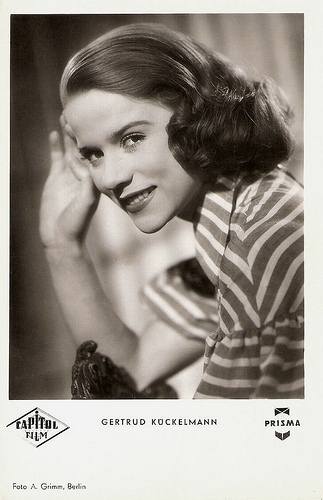
German postcard by Kunst und Bild, Berlin, no. A 798. Photo: Capitol Film / Prisma / Arthur Grimm. Publicity still for Die Stärkere/The Stronger (Wolfgang Liebeneiner, 1953).
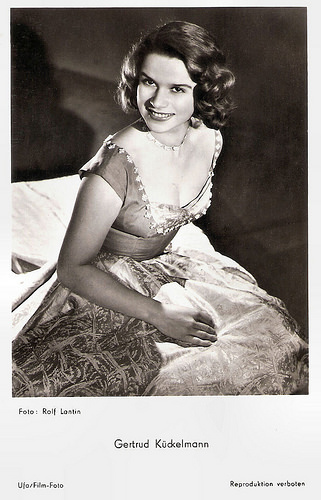
German postcard by Ufa, Berlin-Tempelhof, no. FK 1380. Photo: Rolf Lantin.
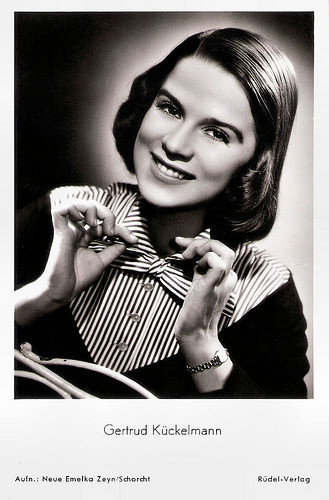
German postcard by F.J. Rüdel, Filmpostkartenverlag, Hamburg-Bergedorf, no. 414. Photo: Neue Emelka / Zeyn / Schorcht. Publicity still for Der Kaplan von San Lorenzo/The chaplain of San Lorenzo (Gustav Ucicky, 1953).
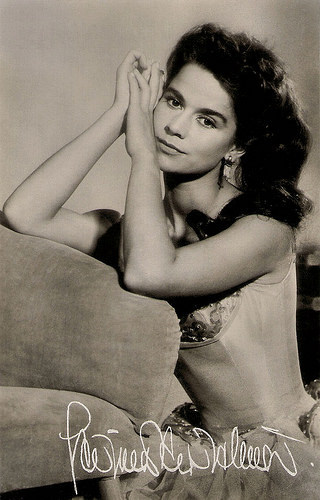
East-German postcard by Progress Film-Verleih, Berlin, no. 225/370, 1957. Photo: DEFA / Kilian. Publicity still for Spielbank-Affäre/Casino Affair (Arthur Pohl, 1957).
Fruit Without Love
Gertrud Christine Franziska Kückelmann was born in 1929 in München (Munich), Germany. Kückelmann was the daughter of the physician Wilhelm Heinrich Ludwig Kückelmann and actress Anna Kückelmann-Guba.
Gertrud spent her school years in Munich and was initially trained as a dancer. At 12, she was a ballet student at the Bavarian State Opera and at 16, she appeared in Gestiefelten Kater (Puss in Boots). She studied singing, began acting classes and in 1949 she signed a long-term contract at the Münchner Kammerspiele.
She made her film debut in the fairytale film Hans im Glück/Hans in Luck (Peter Hamel, 1949) with Gunnar Möller. For her second film role in Rausch einer Nacht/One Night's Intoxication (Eduard von Borsody, 1950), she was awarded with the Bundesfilmpreis (German Film Award) as Best Young Actress.
After that, she was typecast in roles of ‘fragile girls’, and was hardly offered different parts. One of her better films was the comedy Musik bei Nacht/Music by Night (Kurt Hoffmann, 1953) with Paul Hubschmid and Curd Jürgens .
In 1956 she appeared in Frucht ohne Liebe/Fruit Without Love (Ulrich Erfurth, 1956), a Problemfilm (a melodrama with a social problem) on the subject of artificial insemination. The film caused quite a scandal in Germany when it premiered. The churches protested against the film and Kückelmann was also criticised.
When new film roles failed to materialise in West Germany, she made a film for the East German DEFA studio: Spielbank-Affäre/Casino Affair (Arthur Pohl, 1957) with Jan Hendriks . It would be her last film for a long time.
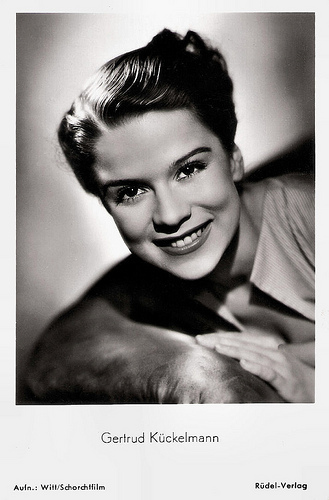
German postcard by Rüdel-Verlag, Hamburg-Bergedorf, no. 564. Photo: Witt / Schorchtfilm. Publicity still for Ei Herz spielt falsch/A Heart's Foul Play (Rudolf Jugert, 1953).
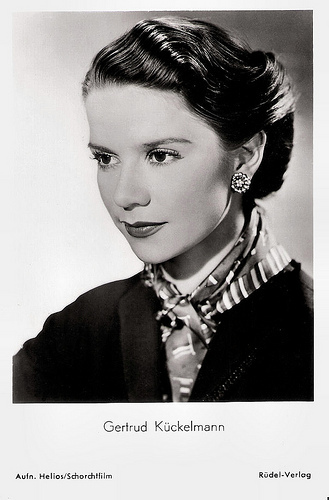
German postcard by Rüdel-Verlag, Hamburg-Bergedorf, no. 626. Photo: Helios / Schorchtfilm. Publicity still for Musik bei Nacht/Music by Night (Kurt Hoffmann, 1953).
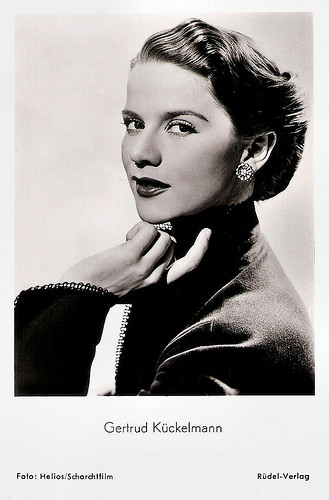
German postcard by Rüdel-Verlag, Hamburg-Bergedorf, no. 673. Photo: Helios / Schorchtfilm. Publicity still for Musik bei Nacht/Music by Night (Kurt Hoffmann, 1953).
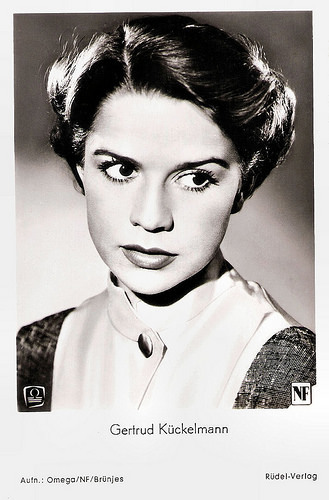
German postcard by Rüdel-Verlag, Hamburg-Bergedorf, no. 1129. Photo: Omega / NF / Brünjes. Publicity still for Der Engel mit dem Flammenschwert/The angel with the flaming sword (Gerhard Lamprecht, 1954).
Longtime Love Affair
Gertrud Kückelmann had a longtime love affair with the actor Oskar Werner . They had met at the set of the Austrian film Mozart (Karl Hartl, 1955) in which Werner starred as the composer and Kückelmann played his wife Constanze. The two often worked together.
Kückelmann also worked as a voice actress. She was e.g. the German voice of Shirley MacLaine in The Apartment (Billy Wilder, 1960) and The Children's Hour (William Wyler, 1961), of Jane Fonda in A Doll's House (Joseph Losey, 1969), and of Charlotte Rampling in The Damned (Luchino Visconti, 1969).
She also appeared in about 100 radio plays and read some fairy tales recordings. In 1968 she married television director Fritz Schuster, but the marriage ended in a divorce in 1971. In 1969, her contract with the Münchner Kammerspiele was ended and in 1970 Kückelmann worked for several months as a nurse.
In 1975 she returned to the cinema in the film Die Angst ist ein zweiter Schatten/Fear Is a Second Shadow, directed by her brother Norbert Kückelmann. It was her final feature film. However, she took part in several television productions and till the end of her life Kückelmann performed on stage. She gave numerous guest performances throughout the German-speaking countries. She both played in classic and modern plays.
Even after surgery for cancer in 1978, she returned once again to the theatre. Her last engagement was at the Berner Stadttheater, but then she was already too ill to perform. In 1979, Gertrud Kückelmann jumped out of a window of the apartment of her brother in Munich. She was 50.
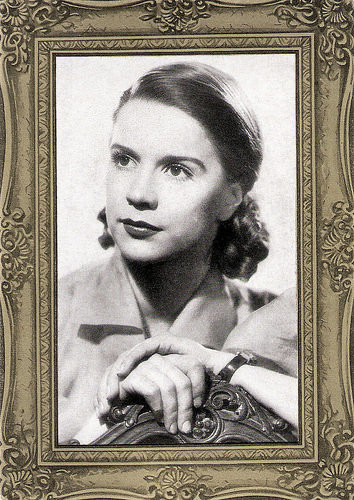
German leaflet. This leaflet contains three pictures and three pages with info on Kückelman and her films.
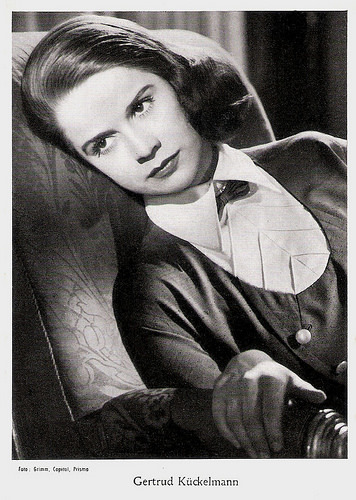
German leaflet. This leaflet contains three pictures and three pages with info on Kückelmann and her films. Photo: Grimm / Capitol / Prisma.
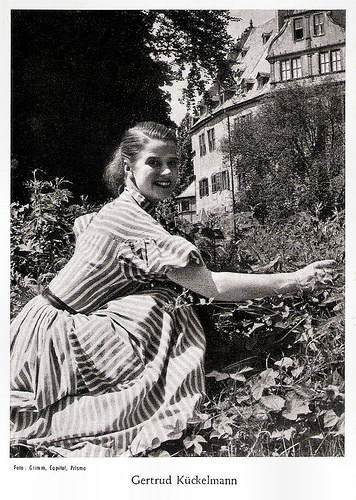
German leaflet. This leaflet contains three pictures and three pages with info on Kückelmann and her films. Photo: Grimm / Capitol / Prisma.
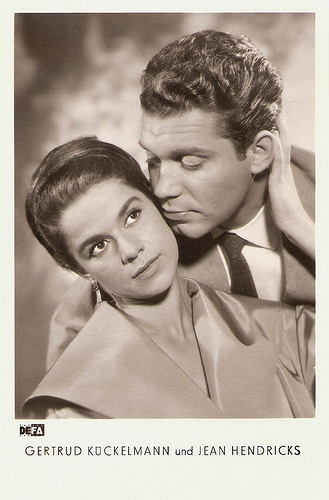
East-German postcard by VEB DEFA-Studio für Spielfilme, Potsdam-Babelsberg, no. 78, 1957, retail price: 0,15 DM. Photo: DEFA / Kilian. Publicity still for Spielbank-Affäre (Arthur Pohl, 1957) with Jan Hendriks .
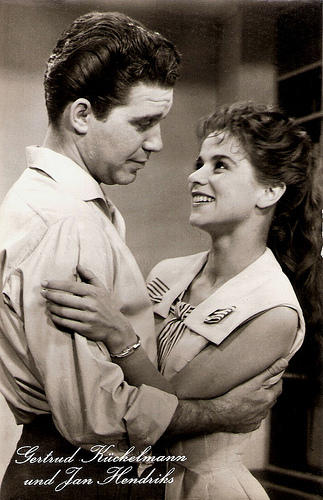
East-German postcard by VEB DEFA-Studio für Spielfilme, Potsdam-Babelsberg, no. 78, 1957, retail price: 0,15 DM. Photo: DEFA / Kilian. Publicity still for Spielbank-Affäre (Arthur Pohl, 1957) with Jan Hendriks .
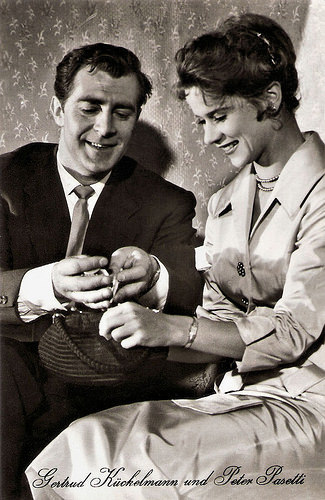
East-German postcard by VEB Progress Filmvertrieb, no. 17/279, 1957. Photo: DEFA / Kilian. Publicity still for Spielbank-Affäre/Casino Affair (Arthur Pohl, 1957) with Peter Pasetti .
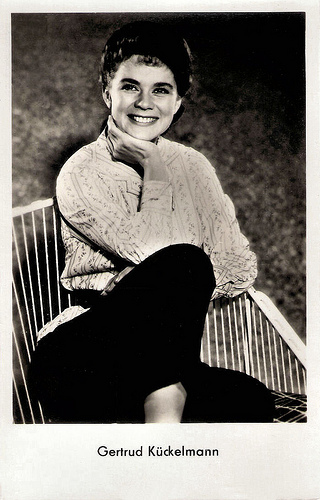
East-German postcard by VEB Progress Filmvertrieb, Berlin, no. 213/236, 1956. Photo: DEFA / Kilian. Publicity still for Spielbank-Affäre/Casino Affair (Arthur Pohl, 1957).
Sources: Luise F. Pusch (FemBio – German), Otto Striebel (Gertrud Kückelmann Gedenkseite – German), Wikipedia (German) and .

German postcard by Kunst und Bild, Berlin, no. A 798. Photo: Capitol Film / Prisma / Arthur Grimm. Publicity still for Die Stärkere/The Stronger (Wolfgang Liebeneiner, 1953).

German postcard by Ufa, Berlin-Tempelhof, no. FK 1380. Photo: Rolf Lantin.

German postcard by F.J. Rüdel, Filmpostkartenverlag, Hamburg-Bergedorf, no. 414. Photo: Neue Emelka / Zeyn / Schorcht. Publicity still for Der Kaplan von San Lorenzo/The chaplain of San Lorenzo (Gustav Ucicky, 1953).

East-German postcard by Progress Film-Verleih, Berlin, no. 225/370, 1957. Photo: DEFA / Kilian. Publicity still for Spielbank-Affäre/Casino Affair (Arthur Pohl, 1957).
Fruit Without Love
Gertrud Christine Franziska Kückelmann was born in 1929 in München (Munich), Germany. Kückelmann was the daughter of the physician Wilhelm Heinrich Ludwig Kückelmann and actress Anna Kückelmann-Guba.
Gertrud spent her school years in Munich and was initially trained as a dancer. At 12, she was a ballet student at the Bavarian State Opera and at 16, she appeared in Gestiefelten Kater (Puss in Boots). She studied singing, began acting classes and in 1949 she signed a long-term contract at the Münchner Kammerspiele.
She made her film debut in the fairytale film Hans im Glück/Hans in Luck (Peter Hamel, 1949) with Gunnar Möller. For her second film role in Rausch einer Nacht/One Night's Intoxication (Eduard von Borsody, 1950), she was awarded with the Bundesfilmpreis (German Film Award) as Best Young Actress.
After that, she was typecast in roles of ‘fragile girls’, and was hardly offered different parts. One of her better films was the comedy Musik bei Nacht/Music by Night (Kurt Hoffmann, 1953) with Paul Hubschmid and Curd Jürgens .
In 1956 she appeared in Frucht ohne Liebe/Fruit Without Love (Ulrich Erfurth, 1956), a Problemfilm (a melodrama with a social problem) on the subject of artificial insemination. The film caused quite a scandal in Germany when it premiered. The churches protested against the film and Kückelmann was also criticised.
When new film roles failed to materialise in West Germany, she made a film for the East German DEFA studio: Spielbank-Affäre/Casino Affair (Arthur Pohl, 1957) with Jan Hendriks . It would be her last film for a long time.

German postcard by Rüdel-Verlag, Hamburg-Bergedorf, no. 564. Photo: Witt / Schorchtfilm. Publicity still for Ei Herz spielt falsch/A Heart's Foul Play (Rudolf Jugert, 1953).

German postcard by Rüdel-Verlag, Hamburg-Bergedorf, no. 626. Photo: Helios / Schorchtfilm. Publicity still for Musik bei Nacht/Music by Night (Kurt Hoffmann, 1953).

German postcard by Rüdel-Verlag, Hamburg-Bergedorf, no. 673. Photo: Helios / Schorchtfilm. Publicity still for Musik bei Nacht/Music by Night (Kurt Hoffmann, 1953).

German postcard by Rüdel-Verlag, Hamburg-Bergedorf, no. 1129. Photo: Omega / NF / Brünjes. Publicity still for Der Engel mit dem Flammenschwert/The angel with the flaming sword (Gerhard Lamprecht, 1954).
Longtime Love Affair
Gertrud Kückelmann had a longtime love affair with the actor Oskar Werner . They had met at the set of the Austrian film Mozart (Karl Hartl, 1955) in which Werner starred as the composer and Kückelmann played his wife Constanze. The two often worked together.
Kückelmann also worked as a voice actress. She was e.g. the German voice of Shirley MacLaine in The Apartment (Billy Wilder, 1960) and The Children's Hour (William Wyler, 1961), of Jane Fonda in A Doll's House (Joseph Losey, 1969), and of Charlotte Rampling in The Damned (Luchino Visconti, 1969).
She also appeared in about 100 radio plays and read some fairy tales recordings. In 1968 she married television director Fritz Schuster, but the marriage ended in a divorce in 1971. In 1969, her contract with the Münchner Kammerspiele was ended and in 1970 Kückelmann worked for several months as a nurse.
In 1975 she returned to the cinema in the film Die Angst ist ein zweiter Schatten/Fear Is a Second Shadow, directed by her brother Norbert Kückelmann. It was her final feature film. However, she took part in several television productions and till the end of her life Kückelmann performed on stage. She gave numerous guest performances throughout the German-speaking countries. She both played in classic and modern plays.
Even after surgery for cancer in 1978, she returned once again to the theatre. Her last engagement was at the Berner Stadttheater, but then she was already too ill to perform. In 1979, Gertrud Kückelmann jumped out of a window of the apartment of her brother in Munich. She was 50.

German leaflet. This leaflet contains three pictures and three pages with info on Kückelman and her films.

German leaflet. This leaflet contains three pictures and three pages with info on Kückelmann and her films. Photo: Grimm / Capitol / Prisma.

German leaflet. This leaflet contains three pictures and three pages with info on Kückelmann and her films. Photo: Grimm / Capitol / Prisma.

East-German postcard by VEB DEFA-Studio für Spielfilme, Potsdam-Babelsberg, no. 78, 1957, retail price: 0,15 DM. Photo: DEFA / Kilian. Publicity still for Spielbank-Affäre (Arthur Pohl, 1957) with Jan Hendriks .

East-German postcard by VEB DEFA-Studio für Spielfilme, Potsdam-Babelsberg, no. 78, 1957, retail price: 0,15 DM. Photo: DEFA / Kilian. Publicity still for Spielbank-Affäre (Arthur Pohl, 1957) with Jan Hendriks .

East-German postcard by VEB Progress Filmvertrieb, no. 17/279, 1957. Photo: DEFA / Kilian. Publicity still for Spielbank-Affäre/Casino Affair (Arthur Pohl, 1957) with Peter Pasetti .

East-German postcard by VEB Progress Filmvertrieb, Berlin, no. 213/236, 1956. Photo: DEFA / Kilian. Publicity still for Spielbank-Affäre/Casino Affair (Arthur Pohl, 1957).
Sources: Luise F. Pusch (FemBio – German), Otto Striebel (Gertrud Kückelmann Gedenkseite – German), Wikipedia (German) and .
Published on May 06, 2016 22:00
May 5, 2016
EFSP's Dazzling Dozen: Ingrid Bergman - Sinner or Saint?
In the 1940s, Swedish actress Ingrid Bergman became one of Hollywood's brightest stars. Whether acting the role of saint or sinner, Bergman found in her characters the extremes of her own devoted and passionate nature. When she fell in love with Italian director Roberto Rossellini, she fell from grace and American authorities branded her "an apostle of degradation". Today twelve collectors cards of two her best roles - as 'sinner' Alicia in Alfred Hitchcock's Notorious (1946) and as Jeanne d'Arc in Joan of Arc (Victor Fleming, 1948). And was Bergman herself a sinner or a saint? Neither, she was a modern Swedish woman and a terrific actress.
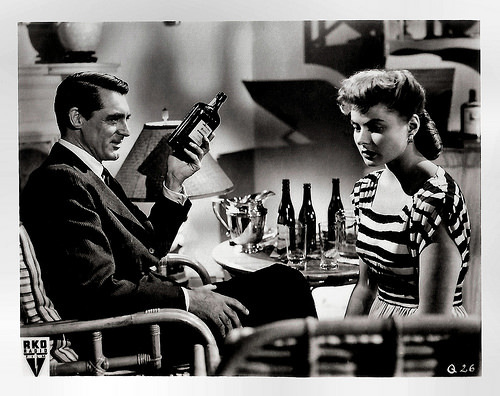
German collectors card. Photo: RKO Radio Film. Publicity still for Notorious (Alfred Hitchcock, 1946).
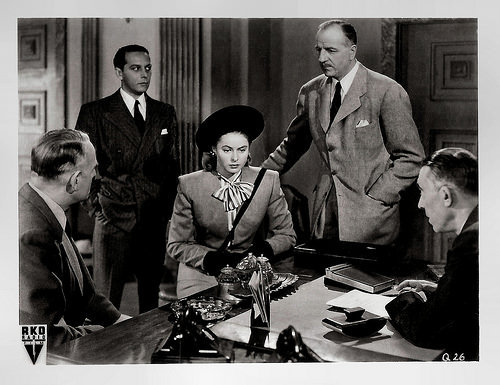
German collectors card. Photo: RKO Radio Film. Publicity still for Notorious (Alfred Hitchcock, 1946) with Louis Calhern (moustache).
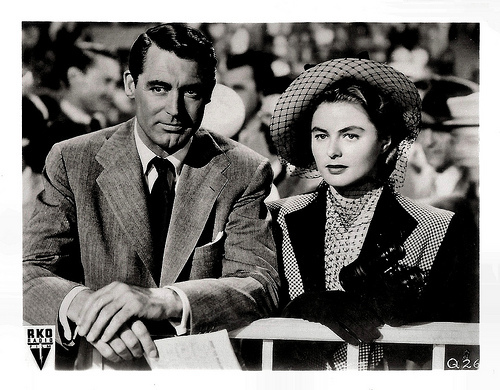
German collectors card. Photo: RKO Radio Film. Publicity still for Notorious (Alfred Hitchcock, 1946) with Cary Grant.
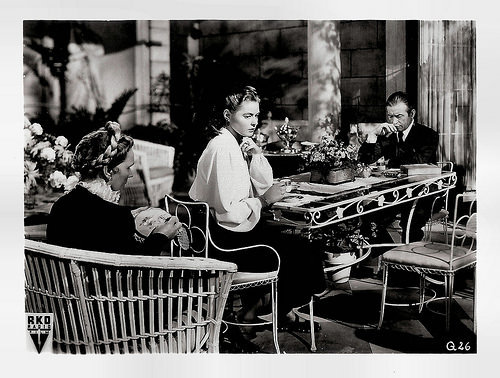
German collectors card. Photo: RKO Radio Film. Publicity still for Notorious (Alfred Hitchcock, 1946) with Claude Rains and Leopoldine Konstantin.
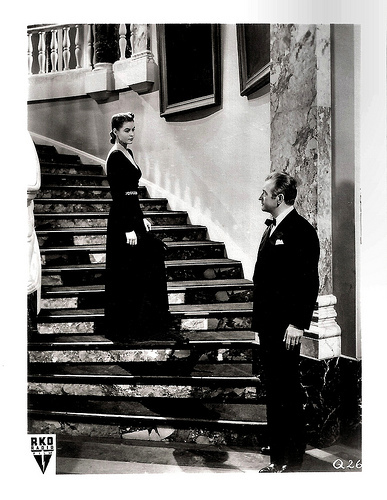
German collectors card. Photo: RKO Radio Film. Publicity still for Notorious (Alfred Hitchcock, 1946) with Claude Rains .
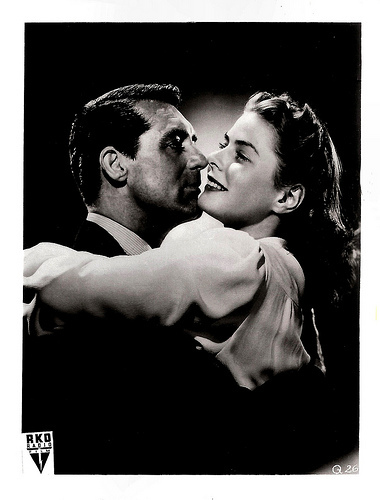
German collectors card. Photo: RKO Radio Film. Publicity still for Notorious (Alfred Hitchcock, 1946) with Cary Grant.
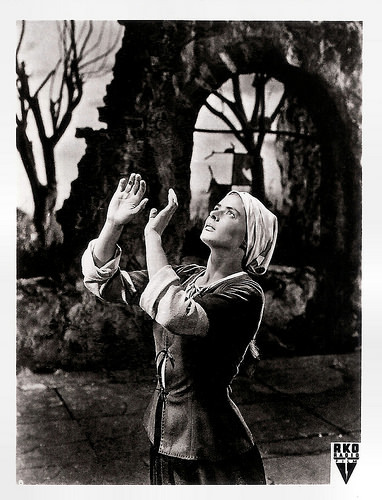
German collectors card, no. 6. Photo: RKO Radio Film. Publicity still for Joan of Arc (Victor Fleming, 1948).
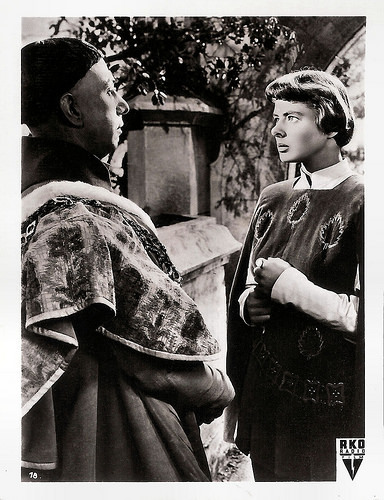
German collectors card, no. 18. Photo: RKO Radio Film. Publicity still for Joan of Arc (Victor Fleming, 1948).
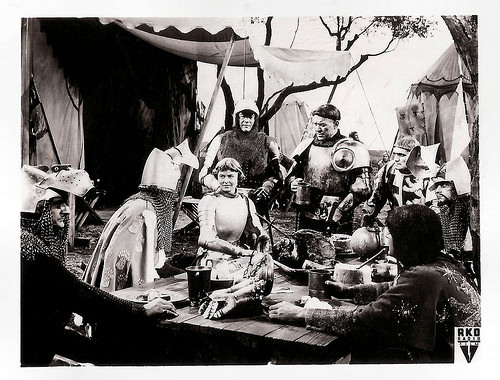
German collectors card. Photo: RKO Radio Film. Publicity still for Joan of Arc (Victor Fleming, 1948).
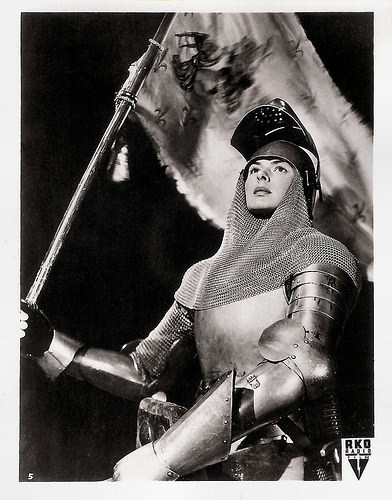
German collectors card. Photo: RKO Radio Film. Publicity still for Joan of Arc (Victor Fleming, 1948).
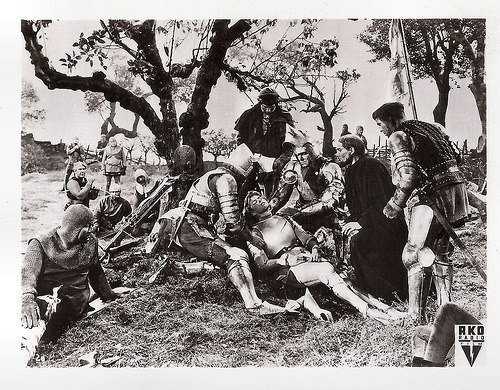
German collectors card. Photo: RKO Radio Film. Publicity still for Joan of Arc (Victor Fleming, 1948).
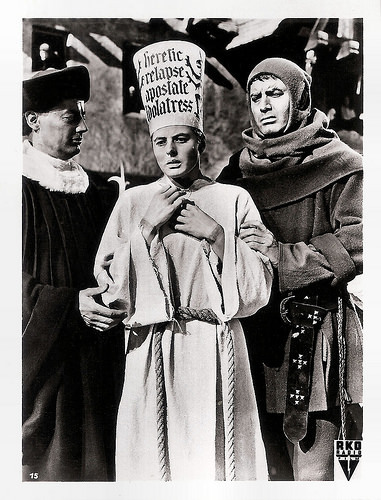
German collectors card, no. 15. Photo: RKO Radio Film. Publicity still for Joan of Arc (Victor Fleming, 1948).
This is a post for Postcard Friendship Friday, hosted by Beth at the The Best Hearts are Crunchy. You can visit her by clicking on the button below.


German collectors card. Photo: RKO Radio Film. Publicity still for Notorious (Alfred Hitchcock, 1946).

German collectors card. Photo: RKO Radio Film. Publicity still for Notorious (Alfred Hitchcock, 1946) with Louis Calhern (moustache).

German collectors card. Photo: RKO Radio Film. Publicity still for Notorious (Alfred Hitchcock, 1946) with Cary Grant.

German collectors card. Photo: RKO Radio Film. Publicity still for Notorious (Alfred Hitchcock, 1946) with Claude Rains and Leopoldine Konstantin.

German collectors card. Photo: RKO Radio Film. Publicity still for Notorious (Alfred Hitchcock, 1946) with Claude Rains .

German collectors card. Photo: RKO Radio Film. Publicity still for Notorious (Alfred Hitchcock, 1946) with Cary Grant.

German collectors card, no. 6. Photo: RKO Radio Film. Publicity still for Joan of Arc (Victor Fleming, 1948).

German collectors card, no. 18. Photo: RKO Radio Film. Publicity still for Joan of Arc (Victor Fleming, 1948).

German collectors card. Photo: RKO Radio Film. Publicity still for Joan of Arc (Victor Fleming, 1948).

German collectors card. Photo: RKO Radio Film. Publicity still for Joan of Arc (Victor Fleming, 1948).

German collectors card. Photo: RKO Radio Film. Publicity still for Joan of Arc (Victor Fleming, 1948).

German collectors card, no. 15. Photo: RKO Radio Film. Publicity still for Joan of Arc (Victor Fleming, 1948).
This is a post for Postcard Friendship Friday, hosted by Beth at the The Best Hearts are Crunchy. You can visit her by clicking on the button below.

Published on May 05, 2016 22:00
May 4, 2016
Elena Lunda
Elena Lunda (1901-1947) was an Italian actress who acted in some 35 silent Italian and German films. She was briefly married to actor Alfredo Bertone.
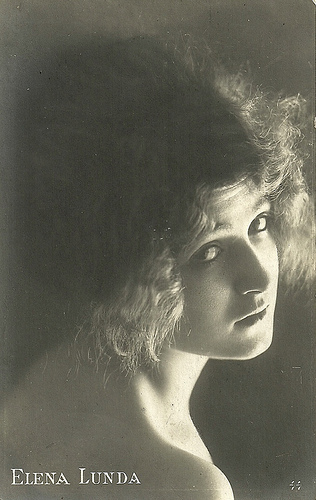
Italian/Romanian postcard by Fotocelere / Edition SARPIC, Bucarest.
Antagonist of Francesca Berini
Elena Lunda was born in 1901 in Palermo, Sicily. She debuted at a young age at the film company Do.Re.Mi. by Lucio D'Ambra in 1919. Her first film there was Passa il drama il Lilliput/Skip the drama in Lilliput (Lucio D'Ambra, 1919), with Romano Calo’.
Soon she shifted to the Cines company for various films. She acted in all kinds of modest film productions in the early 1920s, in which she often had the lead. She was the antagonist of Francesca Bertini in La sfinge/The Sphinx (Roberto Roberti, 1920), Anima selvaggia/Wild Soul (dir. unknown, 1920), Fatale bellezza/Fatal Beauty (Gaston Ravel, 1922) and Oltre la legge/Beyond the law (Gaston Ravel, 1923).
She also appeared opposite Pina Menichelli in La seconda moglie/The Second Wife (Amleto Palermi, 1922) and Occupati d’Amelia/Take Care of Amelia (Telemaco Ruggeri, 1925), and opposite Carmen Boni in Il riscatto/The Redemption (Guglielmo Zorzi, 1924).
When the crisis in the Italian film industry started, she moved to Germany. There she played from 1923 in films with often Italian leads, such as Bohème - Künstlerliebe/La Boheme (Gennaro Righelli, 1923), starring Maria Jacobini as Mimi and Lunda as Musette.
With Angelo Ferrari she acted in Der Racher von Davos/The Avenger of Davos (1924), and with Luciano Albertini in the circus drama Der Mann auf dem Kometen/The Man on the Comet (Alfred Halm, 1925).
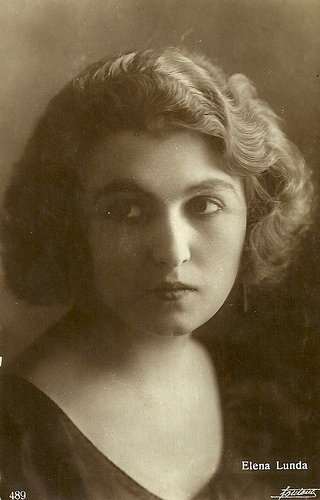
Italian postcard by Ed. A. Traldi, Milano. Photo: Fontana, no. 489.
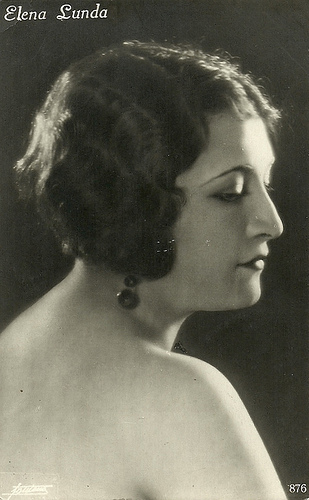
Italian postcard by Ed. A. Traldi, Milano, no. 876.
Opposite Maciste
Elena Lunda also appeared in the German films Frauen, die nicht lieben dürfen/Women who may not love (Geza von Bolvary, 1925) with Olaf Fjord , Frauen, die man of nicht grüsst/Women You Rarely Greet (Frederic Zelnik, 1925) with Lya Mara , Der Liebeskäfig/The Love Trap (Erich Schönflder, Richard Eichberg, 1925) with Johannes Riemann , Die Assmanns/The Assmanns (Arthur Bergen, 1925) with Grete Reinwald, and Der Ritt in die Sonne/The ride in the sun (Georg Jacoby, 1927) with Livio Pavanelli .
After these German films Lunda returned to Italy to act in films by producer Stefano Pittaluga. First she appeared in Il gigante delle Dolomiti/The Giant of the Dolomites (Guido Brignone, 1927), starring Bartolomeo Pagano as Maciste, this time a mountain guide in the Alps.
After the short I martiri d’Italia/The martyrs of Italy (1927), Lunda acted in Gli ultimi zar/The Last Tsars (Baldassarre Negroni, 1928), with again Pagano as Maciste. Her last performance was in La compagnia dei matti/Company and the Crazy (Mario Almirante, 1928), in which a young Vittorio De Sica had a part.
Lunda retired after the death of her husband, actor Alfredo Bertone. The couple had done quite a few films together, including La casa in rovina/The ruined house (Amleto Palermi, 1920), Don Carlos (Giulio Antamoro, 1921) and La seconda moglie/The Second Wife (Amleto Palermi, 1922).
Elena Lunda died in 1947 in Rome, only 46. She and Alfredo Bertone had two daughters.
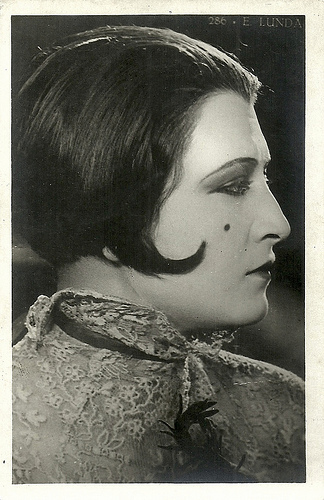
Italian postcard, no. 286.
Sources: Wikipedia (English and Italian) and .

Italian/Romanian postcard by Fotocelere / Edition SARPIC, Bucarest.
Antagonist of Francesca Berini
Elena Lunda was born in 1901 in Palermo, Sicily. She debuted at a young age at the film company Do.Re.Mi. by Lucio D'Ambra in 1919. Her first film there was Passa il drama il Lilliput/Skip the drama in Lilliput (Lucio D'Ambra, 1919), with Romano Calo’.
Soon she shifted to the Cines company for various films. She acted in all kinds of modest film productions in the early 1920s, in which she often had the lead. She was the antagonist of Francesca Bertini in La sfinge/The Sphinx (Roberto Roberti, 1920), Anima selvaggia/Wild Soul (dir. unknown, 1920), Fatale bellezza/Fatal Beauty (Gaston Ravel, 1922) and Oltre la legge/Beyond the law (Gaston Ravel, 1923).
She also appeared opposite Pina Menichelli in La seconda moglie/The Second Wife (Amleto Palermi, 1922) and Occupati d’Amelia/Take Care of Amelia (Telemaco Ruggeri, 1925), and opposite Carmen Boni in Il riscatto/The Redemption (Guglielmo Zorzi, 1924).
When the crisis in the Italian film industry started, she moved to Germany. There she played from 1923 in films with often Italian leads, such as Bohème - Künstlerliebe/La Boheme (Gennaro Righelli, 1923), starring Maria Jacobini as Mimi and Lunda as Musette.
With Angelo Ferrari she acted in Der Racher von Davos/The Avenger of Davos (1924), and with Luciano Albertini in the circus drama Der Mann auf dem Kometen/The Man on the Comet (Alfred Halm, 1925).

Italian postcard by Ed. A. Traldi, Milano. Photo: Fontana, no. 489.

Italian postcard by Ed. A. Traldi, Milano, no. 876.
Opposite Maciste
Elena Lunda also appeared in the German films Frauen, die nicht lieben dürfen/Women who may not love (Geza von Bolvary, 1925) with Olaf Fjord , Frauen, die man of nicht grüsst/Women You Rarely Greet (Frederic Zelnik, 1925) with Lya Mara , Der Liebeskäfig/The Love Trap (Erich Schönflder, Richard Eichberg, 1925) with Johannes Riemann , Die Assmanns/The Assmanns (Arthur Bergen, 1925) with Grete Reinwald, and Der Ritt in die Sonne/The ride in the sun (Georg Jacoby, 1927) with Livio Pavanelli .
After these German films Lunda returned to Italy to act in films by producer Stefano Pittaluga. First she appeared in Il gigante delle Dolomiti/The Giant of the Dolomites (Guido Brignone, 1927), starring Bartolomeo Pagano as Maciste, this time a mountain guide in the Alps.
After the short I martiri d’Italia/The martyrs of Italy (1927), Lunda acted in Gli ultimi zar/The Last Tsars (Baldassarre Negroni, 1928), with again Pagano as Maciste. Her last performance was in La compagnia dei matti/Company and the Crazy (Mario Almirante, 1928), in which a young Vittorio De Sica had a part.
Lunda retired after the death of her husband, actor Alfredo Bertone. The couple had done quite a few films together, including La casa in rovina/The ruined house (Amleto Palermi, 1920), Don Carlos (Giulio Antamoro, 1921) and La seconda moglie/The Second Wife (Amleto Palermi, 1922).
Elena Lunda died in 1947 in Rome, only 46. She and Alfredo Bertone had two daughters.

Italian postcard, no. 286.
Sources: Wikipedia (English and Italian) and .
Published on May 04, 2016 22:00
May 3, 2016
If... (1968)
The British film If... (1968), produced and directed by Lindsay Anderson, and starring Malcolm McDowell in his film debut, was a highly acclaimed but controversial drama. It paints a black picture of the British school system and, by extension, English society. Today we post a series of cards published for the British DVD release of the film in 2007.
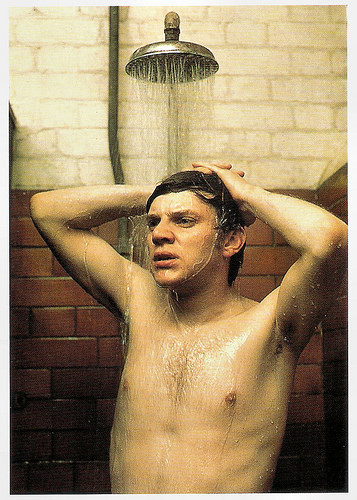
British postcard by Paramount Pictures for the DVD release (2007), no. GI101327PK. Photo: Paramount Pictures. Publicity still for If... (Lindsay Anderson, 1968) with Malcolm McDowell.
Daring and unpredictable in content and form
In If... (Lindsay Anderson, 1968), rebellious students at an old established private school in England plan a violent revolt against their repressive environment.
The film centres on a small group of non-conformists led by Mick Travis (Malcolm McDowell in his first screen role). Seeing the powers-that-be as humourless, bureaucratic, and needlessly restrictive, Mick and his cohorts (including Richard Warwick and David Wood) indulge in small acts of rebellion, including sneaking into town to romance a local waitress (Christine Noonan). Their actions are discovered and punished with harsh beatings, leading the students to plot revenge.
Judd Blaise at AllMovie : "This effort culminates in the film's most famous sequence, a surrealistic depiction of a bloody uprising by the students against the adult world. Daring and unpredictable in content and form, If... mixes colour and black-and-white cinematography as easily as it mingles satire with dark fantasy."
If... is often compared to the French classic Zéro de conduite (Jean Vigo, 1933), which also featured surrealistic boarding-school rebellion. According to Wikipedia , Anderson acknowledged an influence, and described how he arranged a viewing of Zéro de conduite with his screenwriters, David Sherwin and John Howlett.
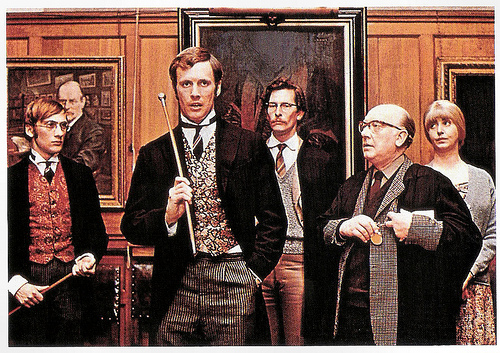
British postcard by Paramount Pictures for the DVD release (2007), no. GI101327PK. Photo: Paramount Pictures. Publicity still for If... (Lindsay Anderson, 1968) with Hugh Thomas, Robert Swann, Ben Aris, Arthur Lowe and Mary MacLeod.
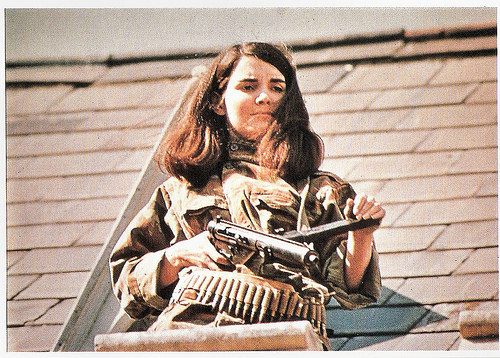
British postcard by Paramount Pictures for the DVD release (2007), no. GI101327PK. Photo: Paramount Pictures. Publicity still for If... (Lindsay Anderson, 1968) with Christine Noonan.
Power to Shock
The film's ambiguous attitude toward violence was fairly controversial in 1968. If... became a success among younger, counter-culture audiences who appreciated the audacious shock tactics and embraced the satirical, anti-establishment message. The film received BAFTA and Golden Globe nominations and won the Palme d'Or at the 1969 Cannes Film Festival.
Rebecca Flint Marx at AllMovie : "the film still has the power to shock, not so much because of its sex and violence (fairly tame by today's standards) but because of the manner in which they are presented. Resembling a landlocked Lord of the Flies, If... remains most startling for its depiction of savagery, on the part of both society (represented by the school and its authorities) and the young men it produces. It is a casual, offhand savagery, seemingly as much a part of British society as tea and scones. Lindsay Anderson's ambiguous approach to the film's violence is consistent with the film's blackly satirical tone, mirroring the aim being taken at societies across the world at the time by their dissatisfied youth."
If... has become a high point in the cinema of youth rebellion. His role earned Malcolm McDowell the part of Alex in the classic A Clockwork Orange (Stanley Kubrick, 1971). Director Lindsay Anderson and McDowell later collaborated on O Lucky Man! (1973), Look Back in Anger (1980), and Britannia Hospital (1982).
Shawn Taber at IMDb about If...: "This is one of the greatest films ever made, period! I've seen it at least 10 times, and it still manages to captivate me."
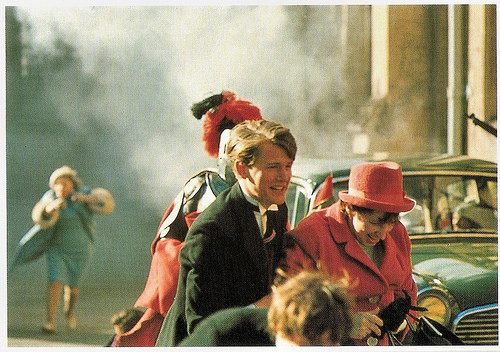
British postcard by Paramount Pictures for the DVD release (2007), no. GI101327PK. Photo: Paramount Pictures. Publicity still for If... (Lindsay Anderson, 1968).
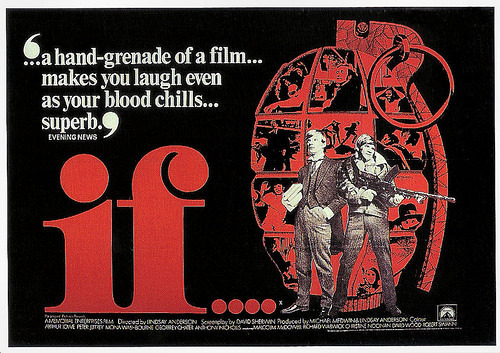
British postcard by Paramount Pictures for the DVD release (2007), no. GI101327PK. Photo: Paramount Pictures. Poster for If... (Lindsay Anderson, 1968).
Sources: Rebecca Flint Marx (AllMovie), Judd Blaise (AllMovie), Shawn Taber (IMDb), Wikipedia and IMDb.

British postcard by Paramount Pictures for the DVD release (2007), no. GI101327PK. Photo: Paramount Pictures. Publicity still for If... (Lindsay Anderson, 1968) with Malcolm McDowell.
Daring and unpredictable in content and form
In If... (Lindsay Anderson, 1968), rebellious students at an old established private school in England plan a violent revolt against their repressive environment.
The film centres on a small group of non-conformists led by Mick Travis (Malcolm McDowell in his first screen role). Seeing the powers-that-be as humourless, bureaucratic, and needlessly restrictive, Mick and his cohorts (including Richard Warwick and David Wood) indulge in small acts of rebellion, including sneaking into town to romance a local waitress (Christine Noonan). Their actions are discovered and punished with harsh beatings, leading the students to plot revenge.
Judd Blaise at AllMovie : "This effort culminates in the film's most famous sequence, a surrealistic depiction of a bloody uprising by the students against the adult world. Daring and unpredictable in content and form, If... mixes colour and black-and-white cinematography as easily as it mingles satire with dark fantasy."
If... is often compared to the French classic Zéro de conduite (Jean Vigo, 1933), which also featured surrealistic boarding-school rebellion. According to Wikipedia , Anderson acknowledged an influence, and described how he arranged a viewing of Zéro de conduite with his screenwriters, David Sherwin and John Howlett.

British postcard by Paramount Pictures for the DVD release (2007), no. GI101327PK. Photo: Paramount Pictures. Publicity still for If... (Lindsay Anderson, 1968) with Hugh Thomas, Robert Swann, Ben Aris, Arthur Lowe and Mary MacLeod.

British postcard by Paramount Pictures for the DVD release (2007), no. GI101327PK. Photo: Paramount Pictures. Publicity still for If... (Lindsay Anderson, 1968) with Christine Noonan.
Power to Shock
The film's ambiguous attitude toward violence was fairly controversial in 1968. If... became a success among younger, counter-culture audiences who appreciated the audacious shock tactics and embraced the satirical, anti-establishment message. The film received BAFTA and Golden Globe nominations and won the Palme d'Or at the 1969 Cannes Film Festival.
Rebecca Flint Marx at AllMovie : "the film still has the power to shock, not so much because of its sex and violence (fairly tame by today's standards) but because of the manner in which they are presented. Resembling a landlocked Lord of the Flies, If... remains most startling for its depiction of savagery, on the part of both society (represented by the school and its authorities) and the young men it produces. It is a casual, offhand savagery, seemingly as much a part of British society as tea and scones. Lindsay Anderson's ambiguous approach to the film's violence is consistent with the film's blackly satirical tone, mirroring the aim being taken at societies across the world at the time by their dissatisfied youth."
If... has become a high point in the cinema of youth rebellion. His role earned Malcolm McDowell the part of Alex in the classic A Clockwork Orange (Stanley Kubrick, 1971). Director Lindsay Anderson and McDowell later collaborated on O Lucky Man! (1973), Look Back in Anger (1980), and Britannia Hospital (1982).
Shawn Taber at IMDb about If...: "This is one of the greatest films ever made, period! I've seen it at least 10 times, and it still manages to captivate me."

British postcard by Paramount Pictures for the DVD release (2007), no. GI101327PK. Photo: Paramount Pictures. Publicity still for If... (Lindsay Anderson, 1968).

British postcard by Paramount Pictures for the DVD release (2007), no. GI101327PK. Photo: Paramount Pictures. Poster for If... (Lindsay Anderson, 1968).
Sources: Rebecca Flint Marx (AllMovie), Judd Blaise (AllMovie), Shawn Taber (IMDb), Wikipedia and IMDb.
Published on May 03, 2016 22:00
Paul van Yperen's Blog
- Paul van Yperen's profile
- 13 followers
Paul van Yperen isn't a Goodreads Author
(yet),
but they
do have a blog,
so here are some recent posts imported from
their feed.



